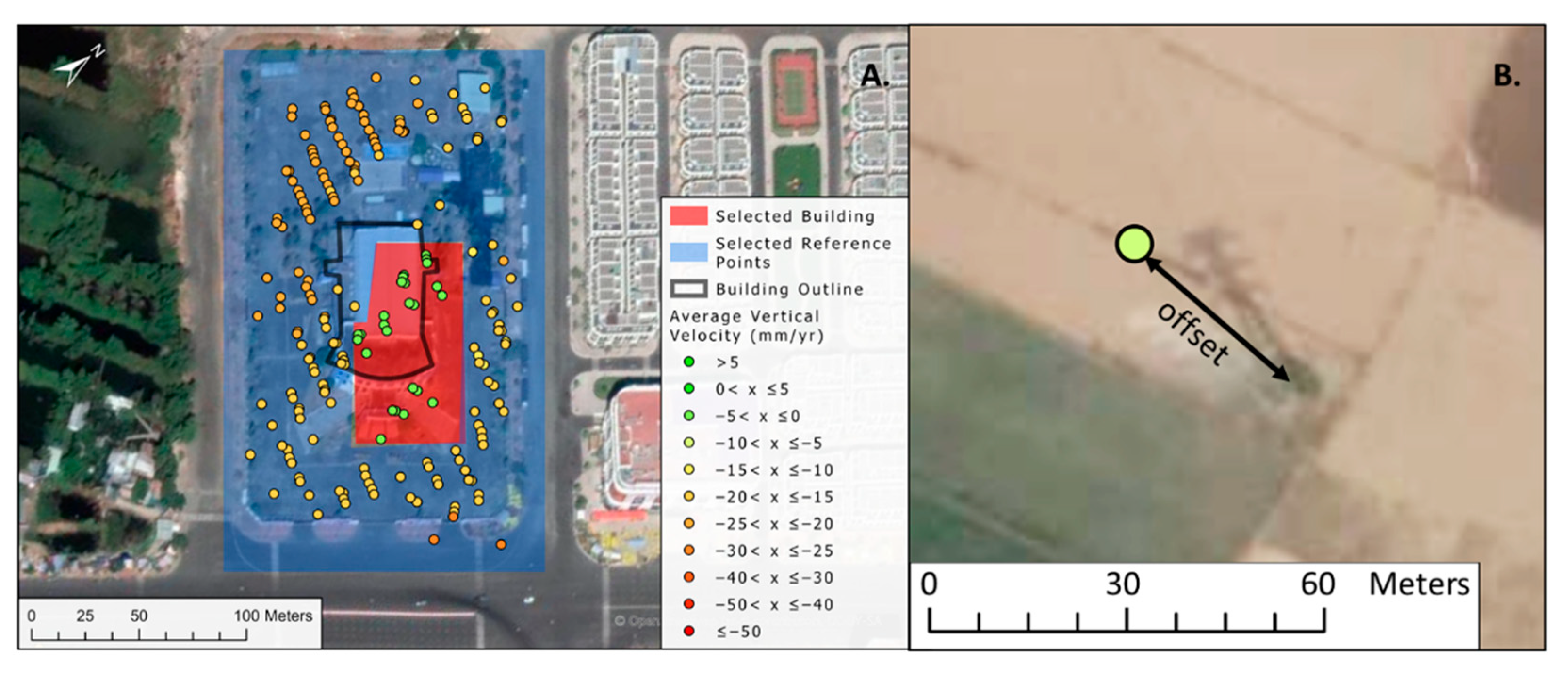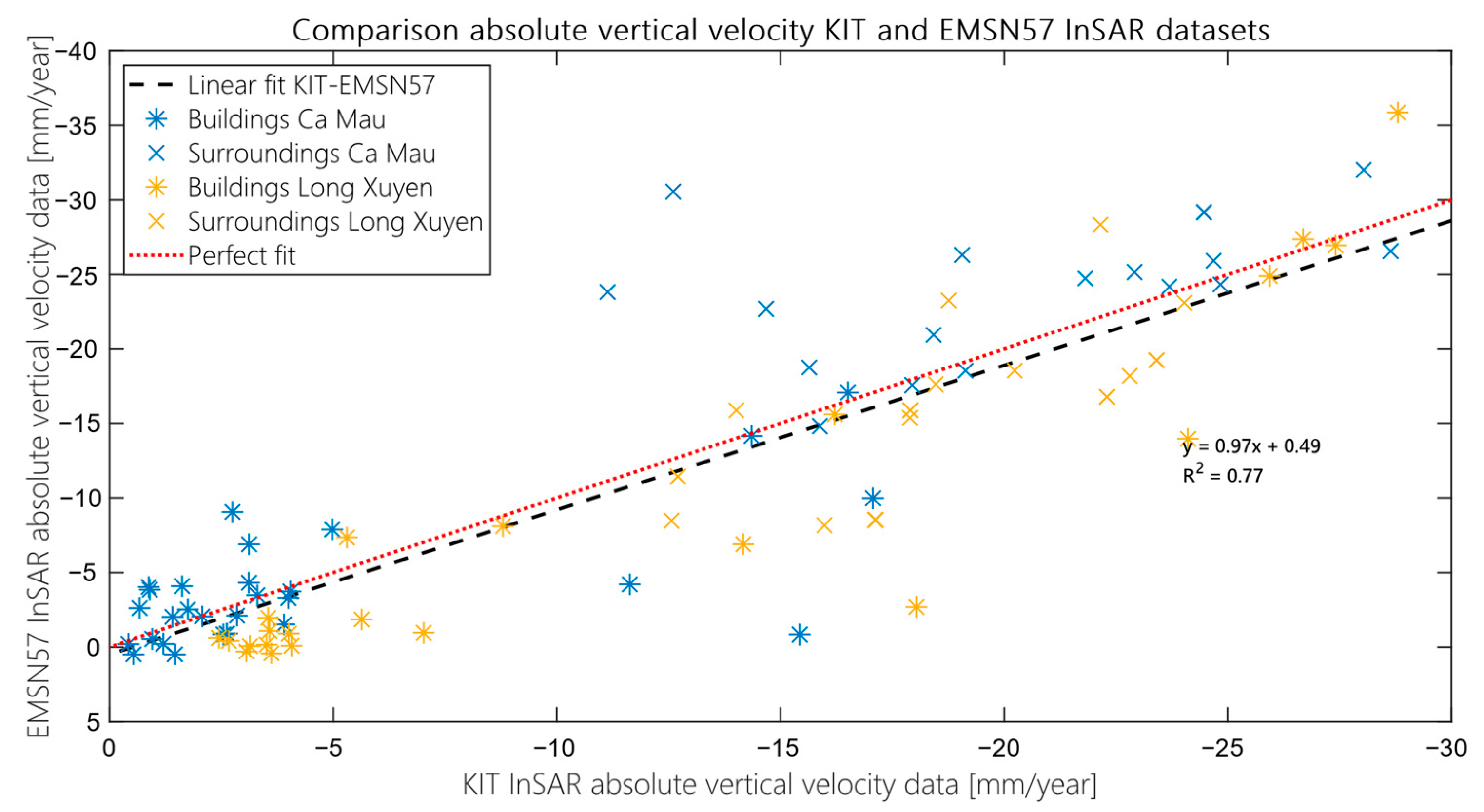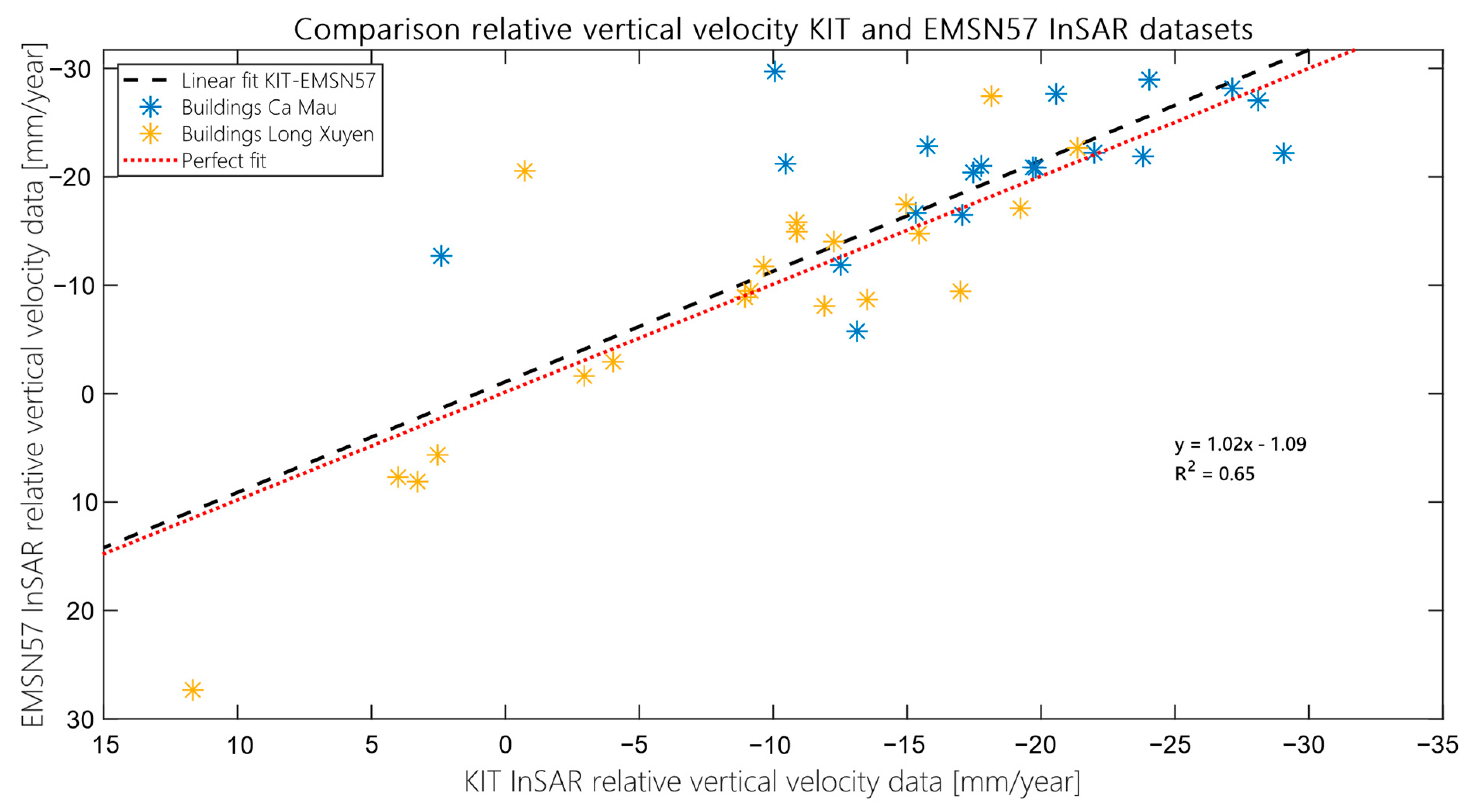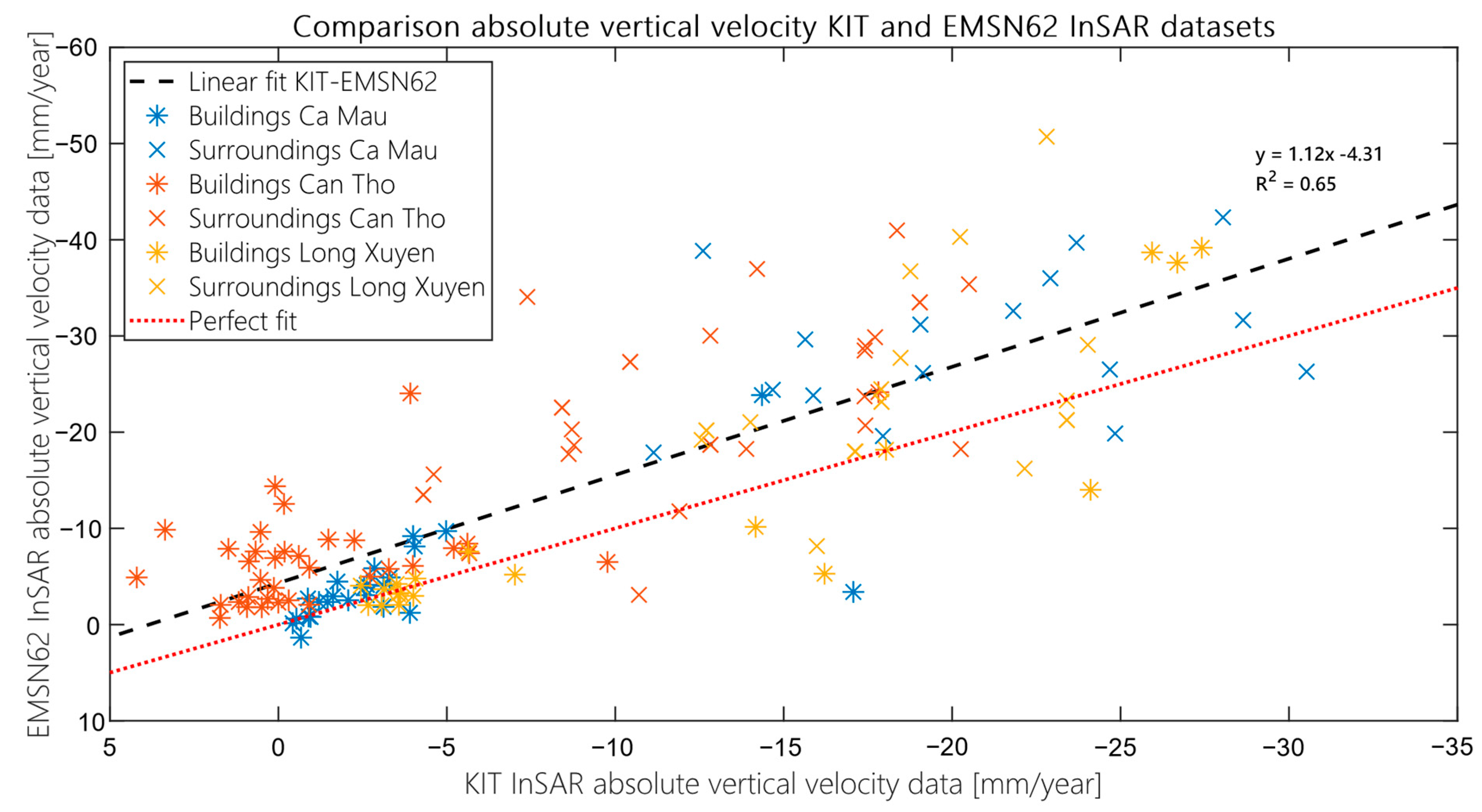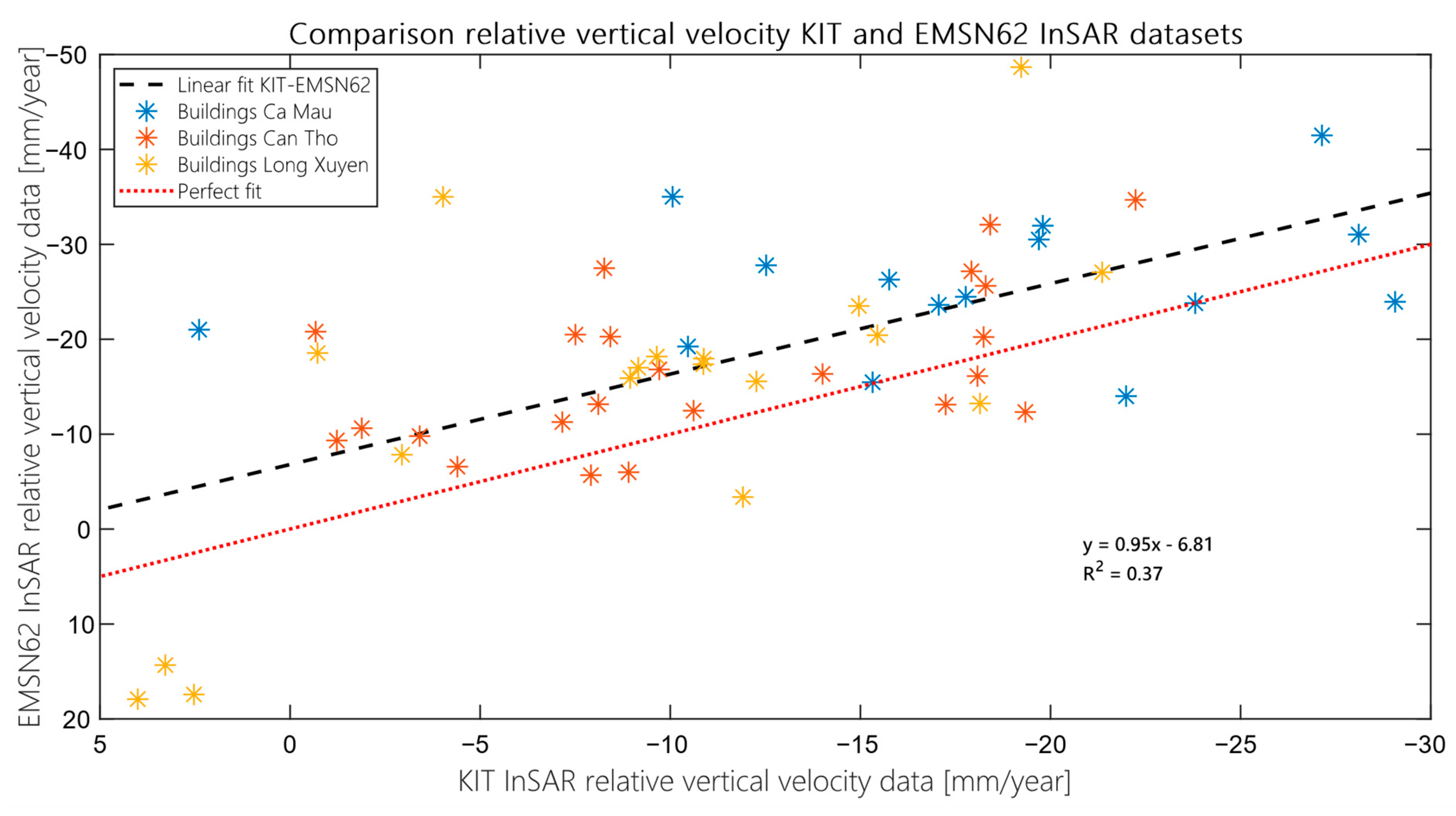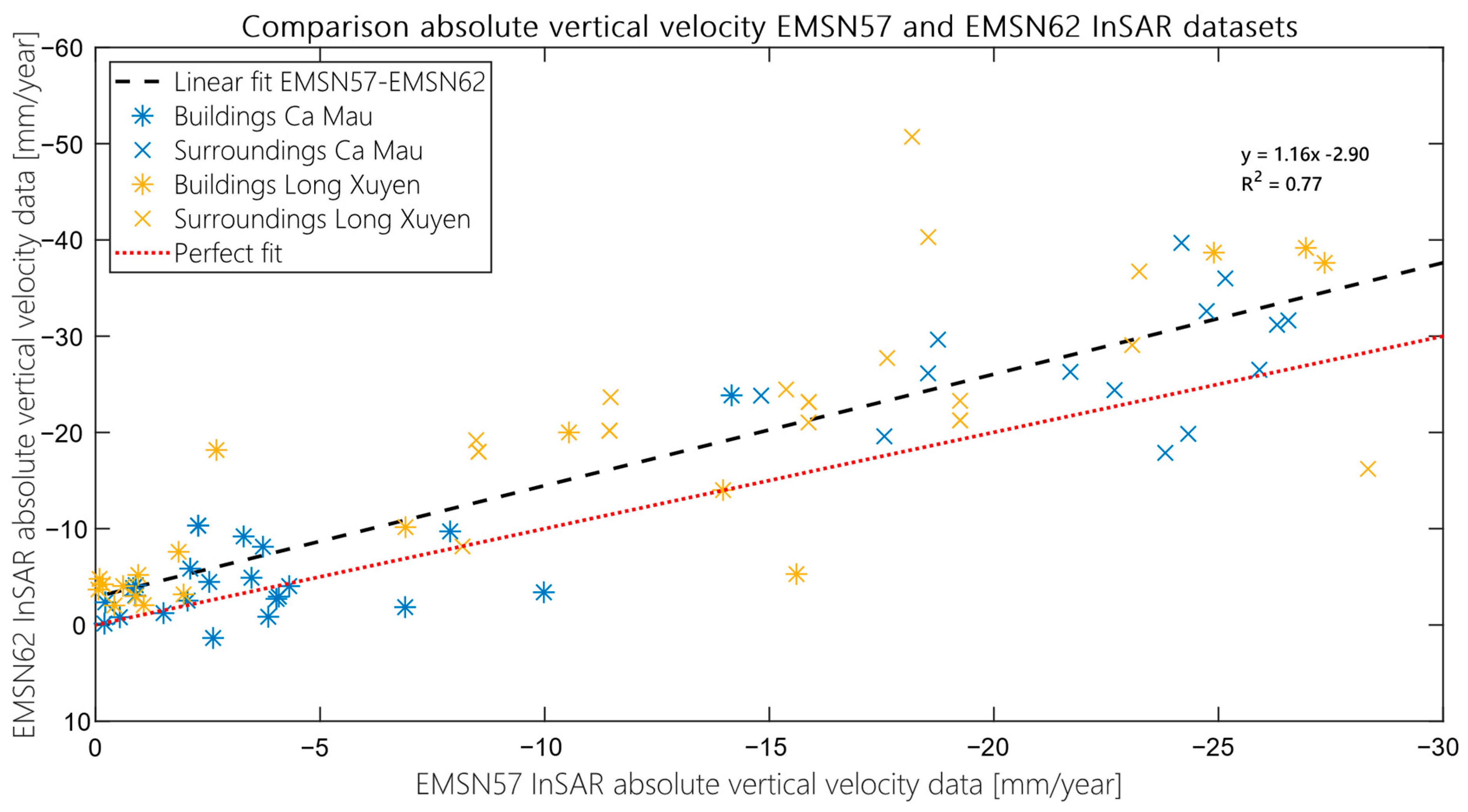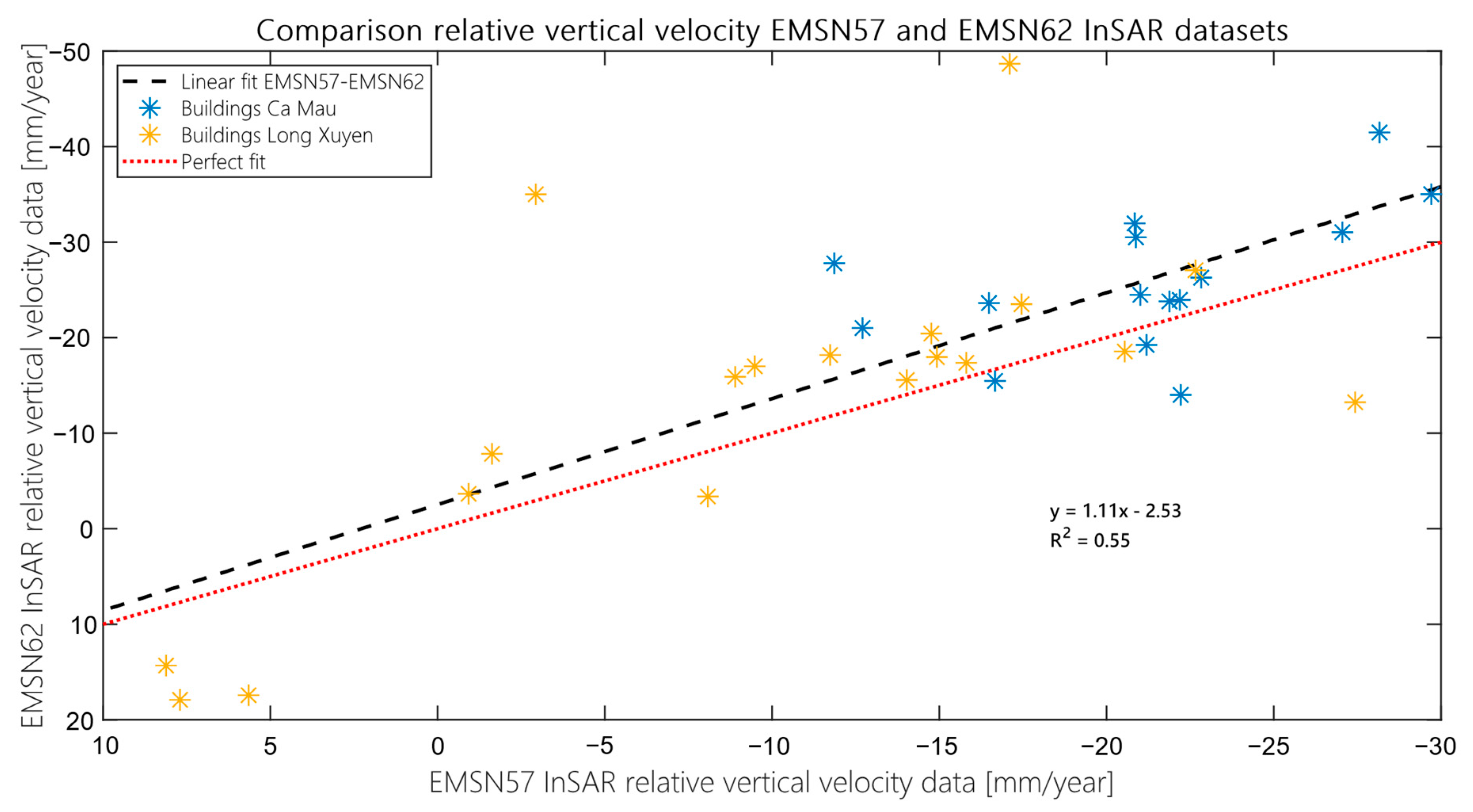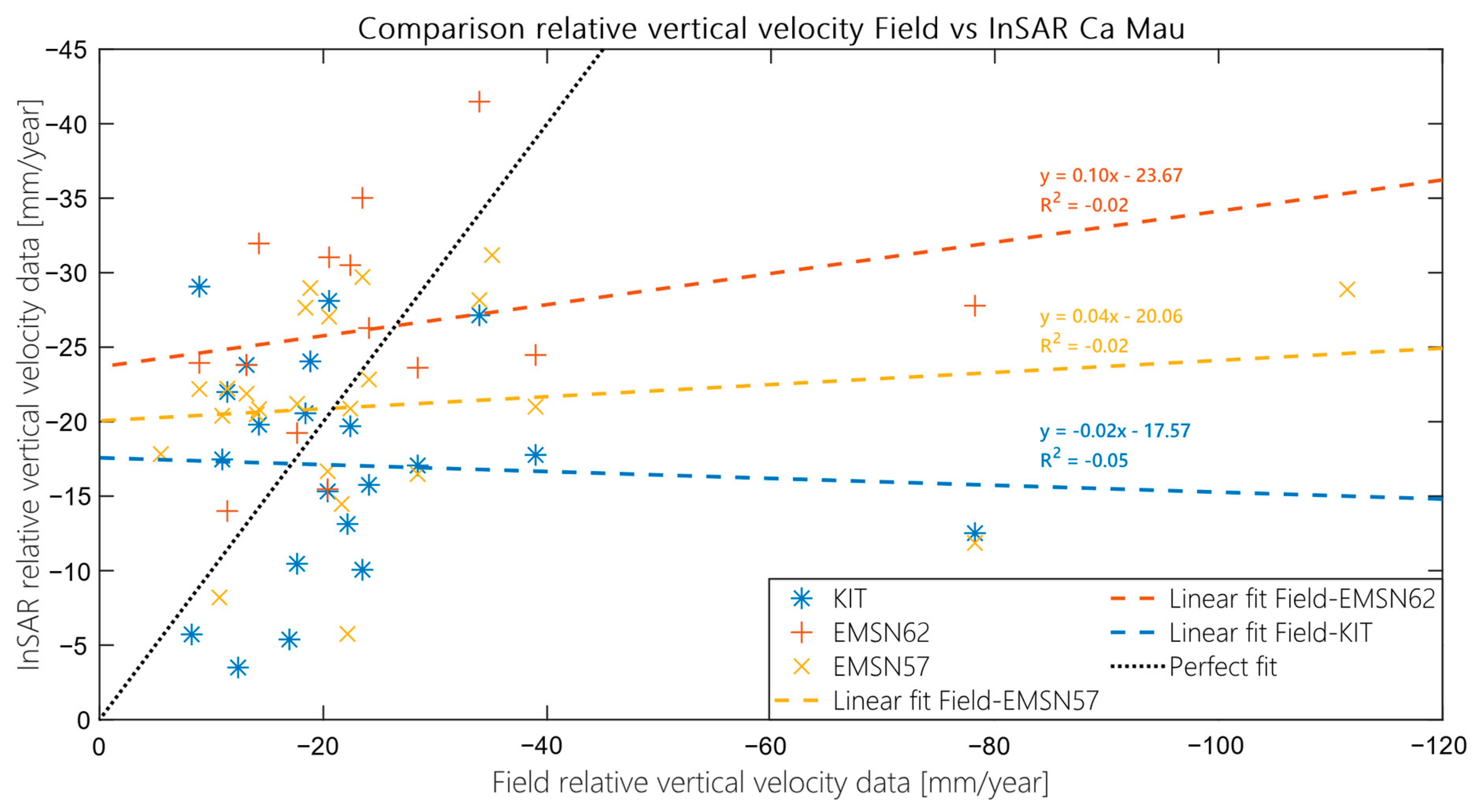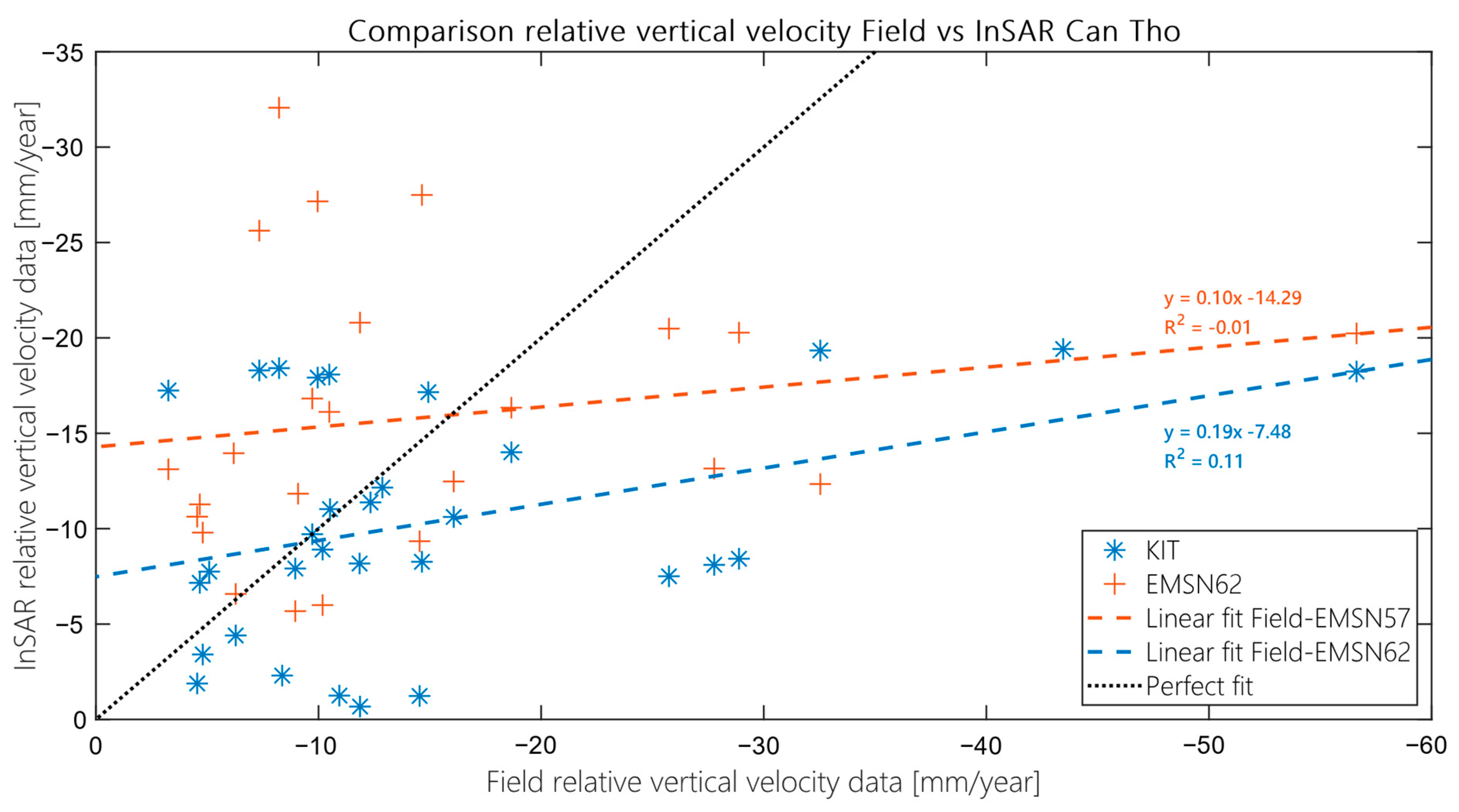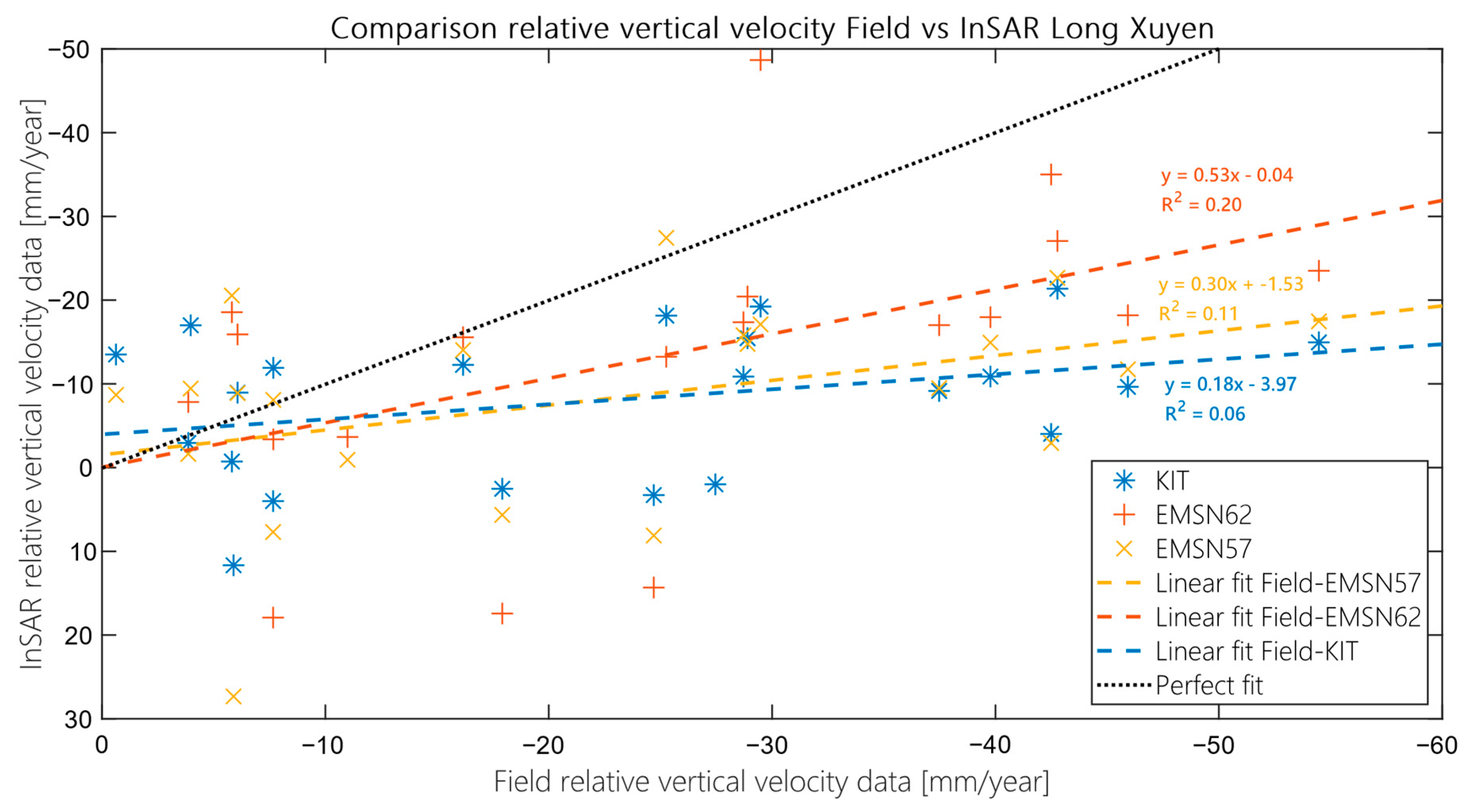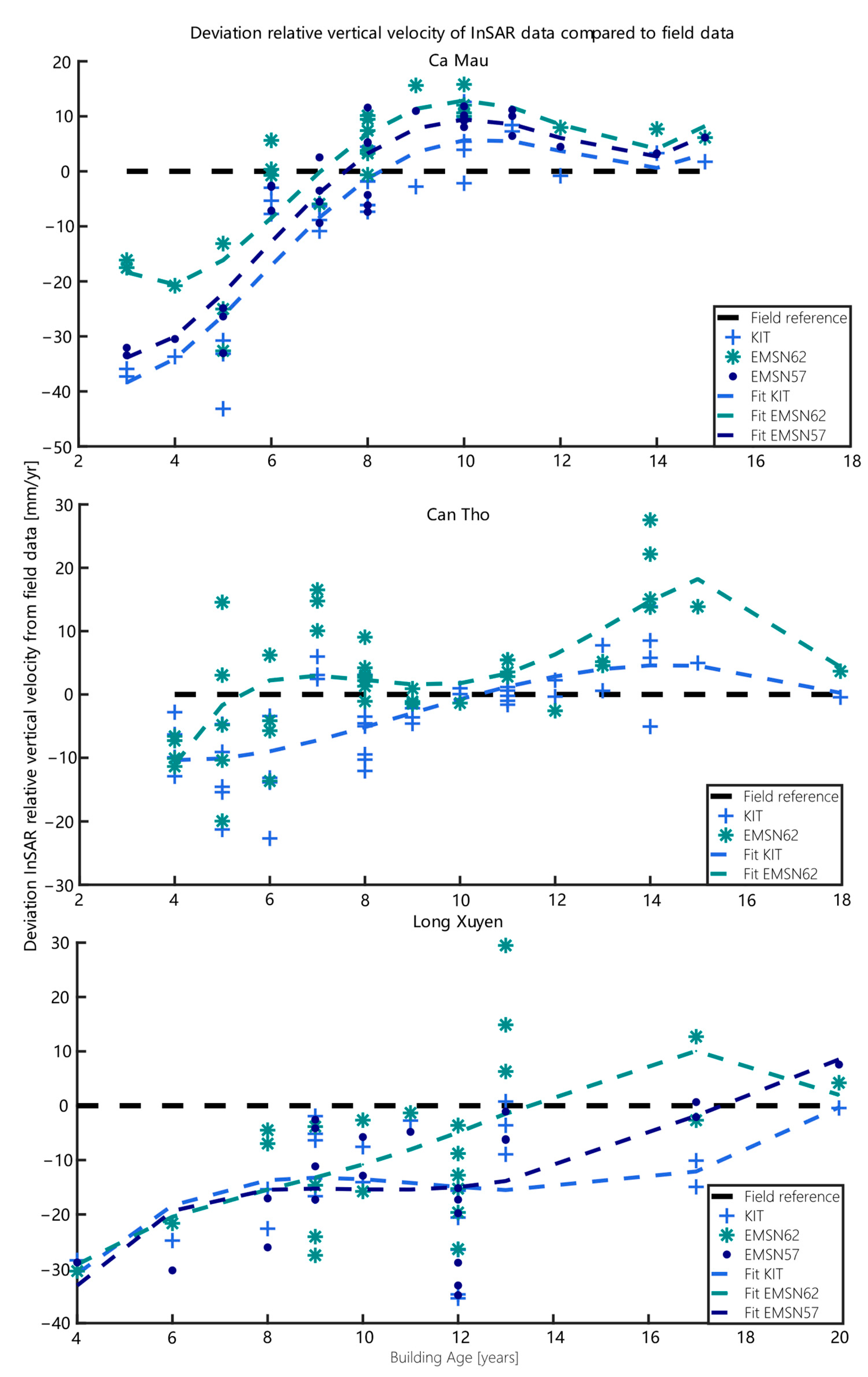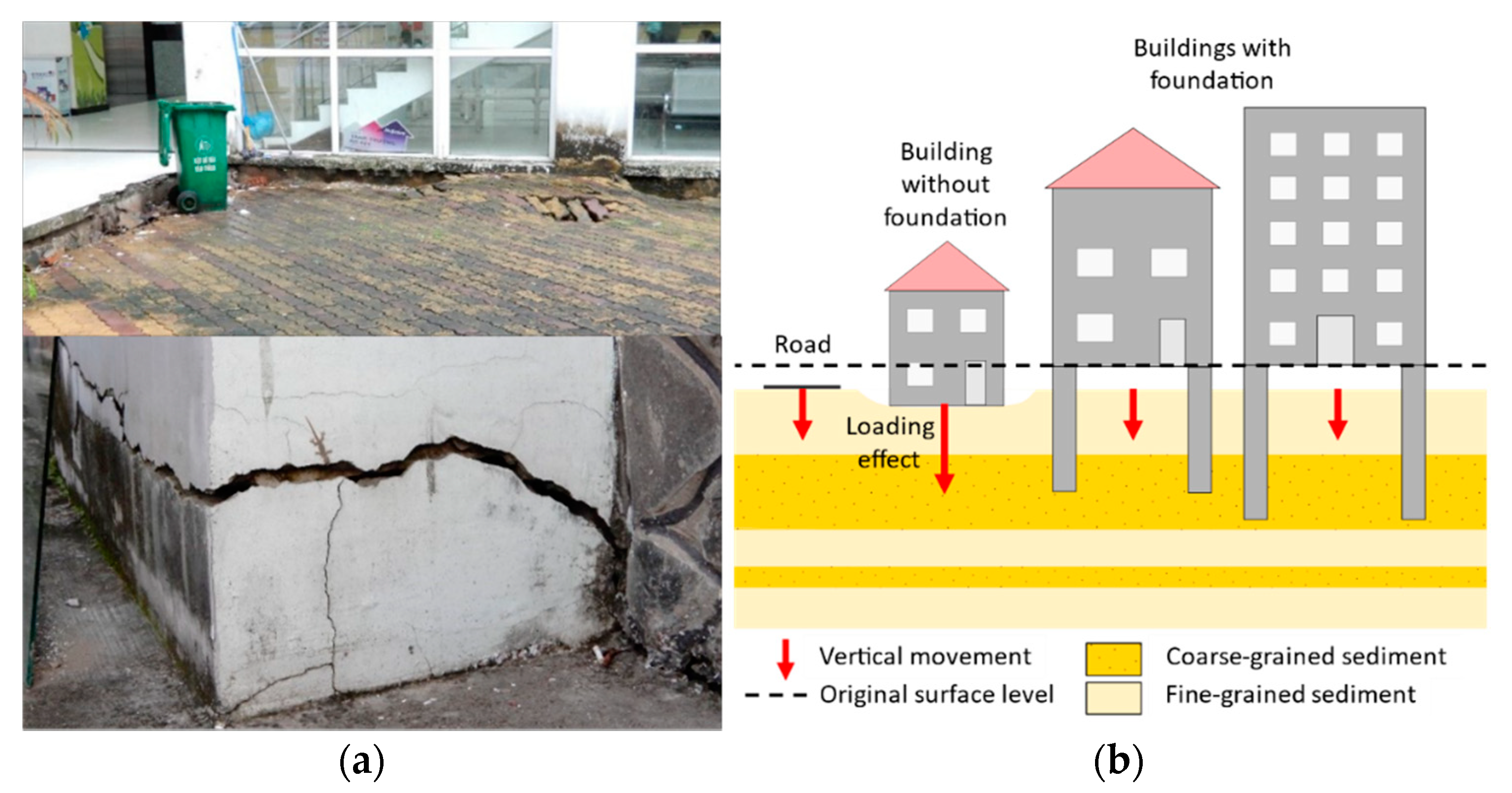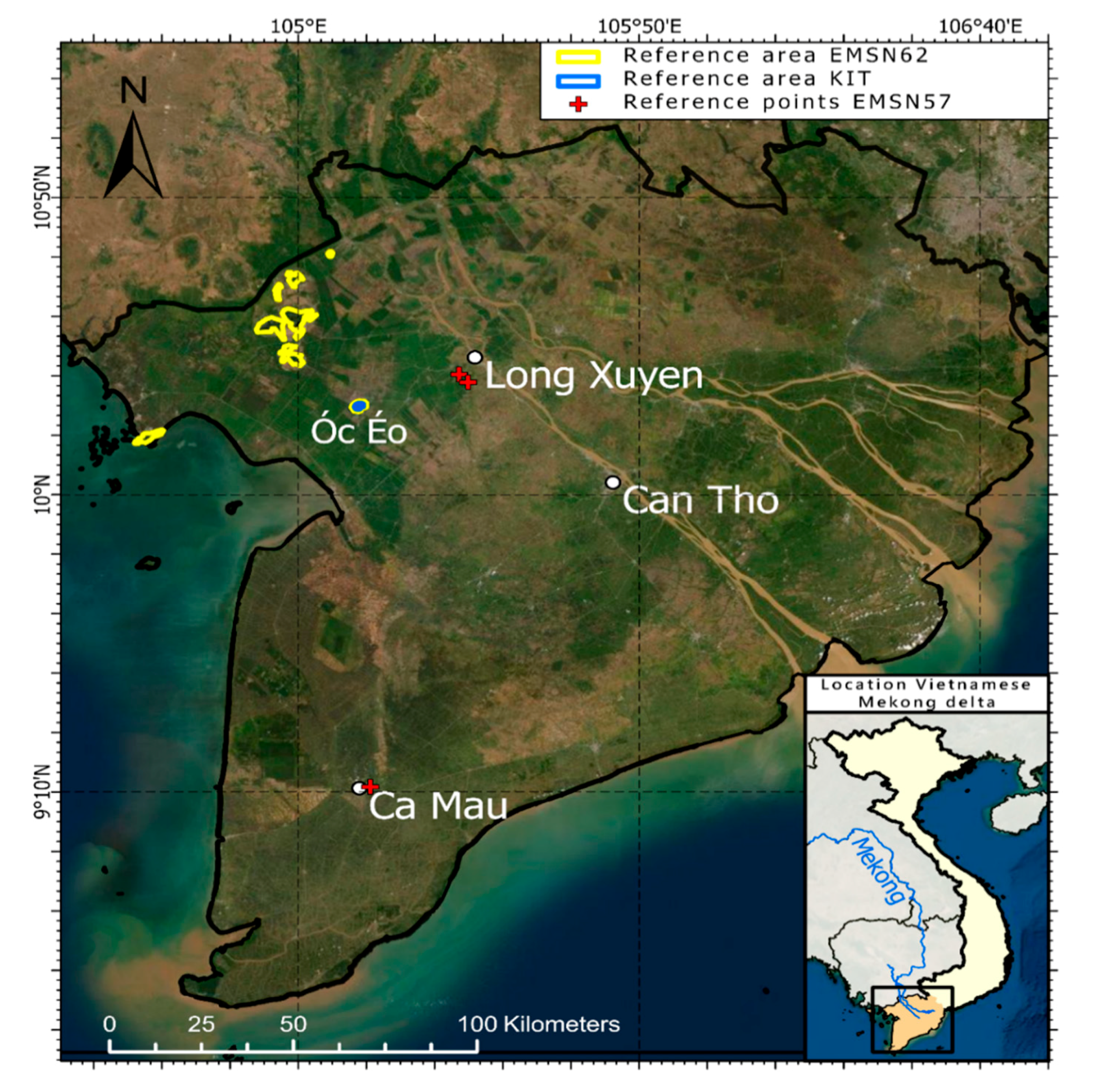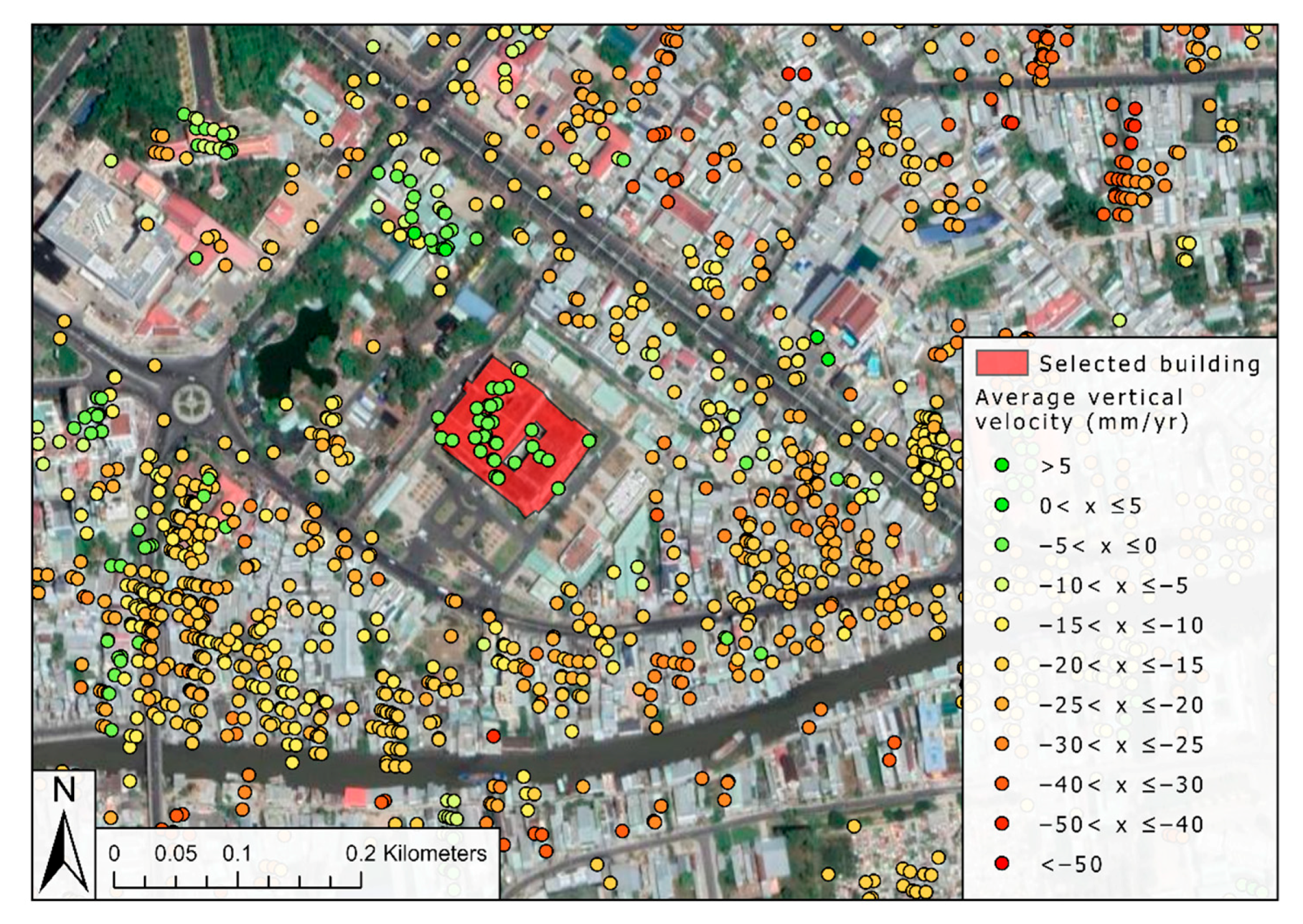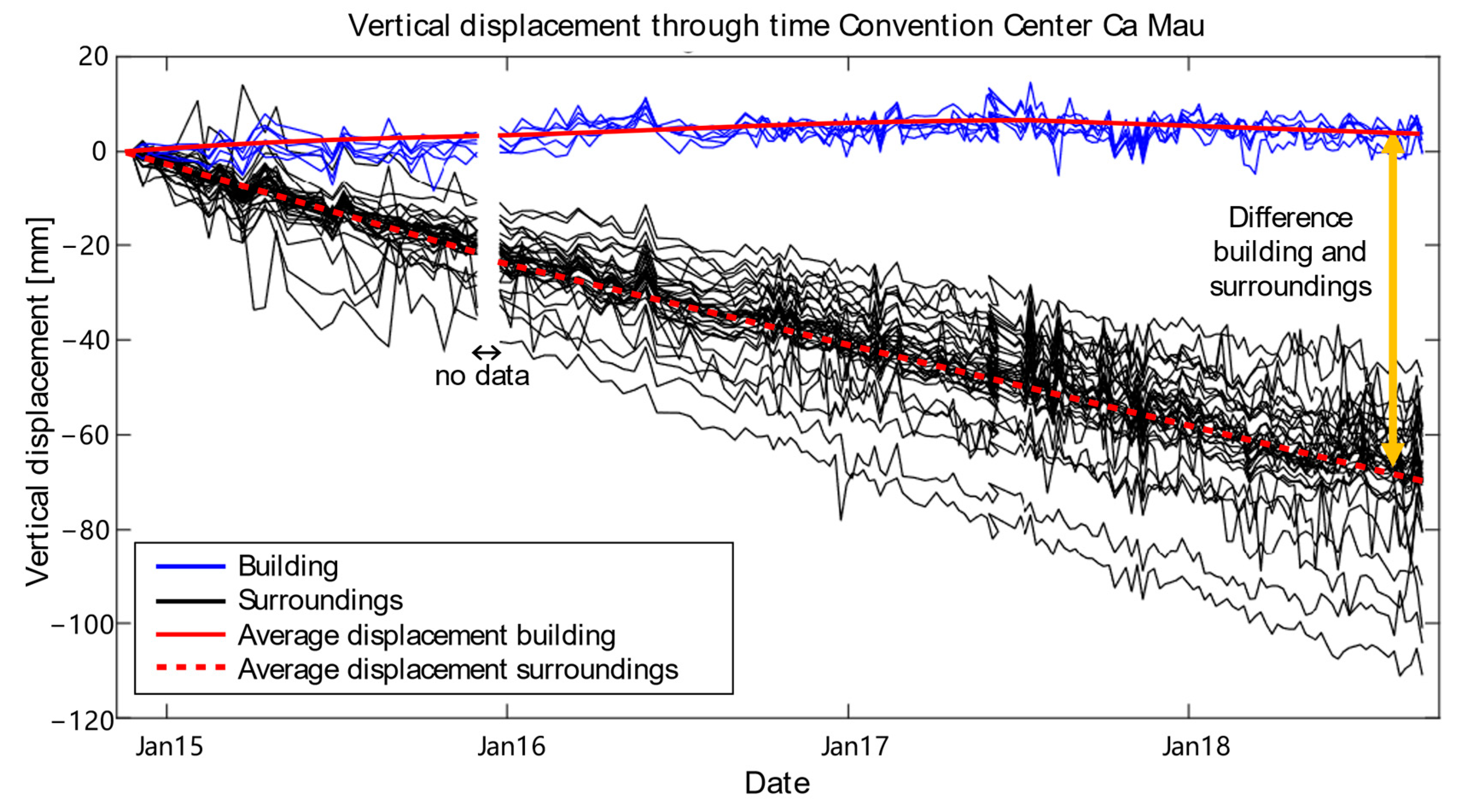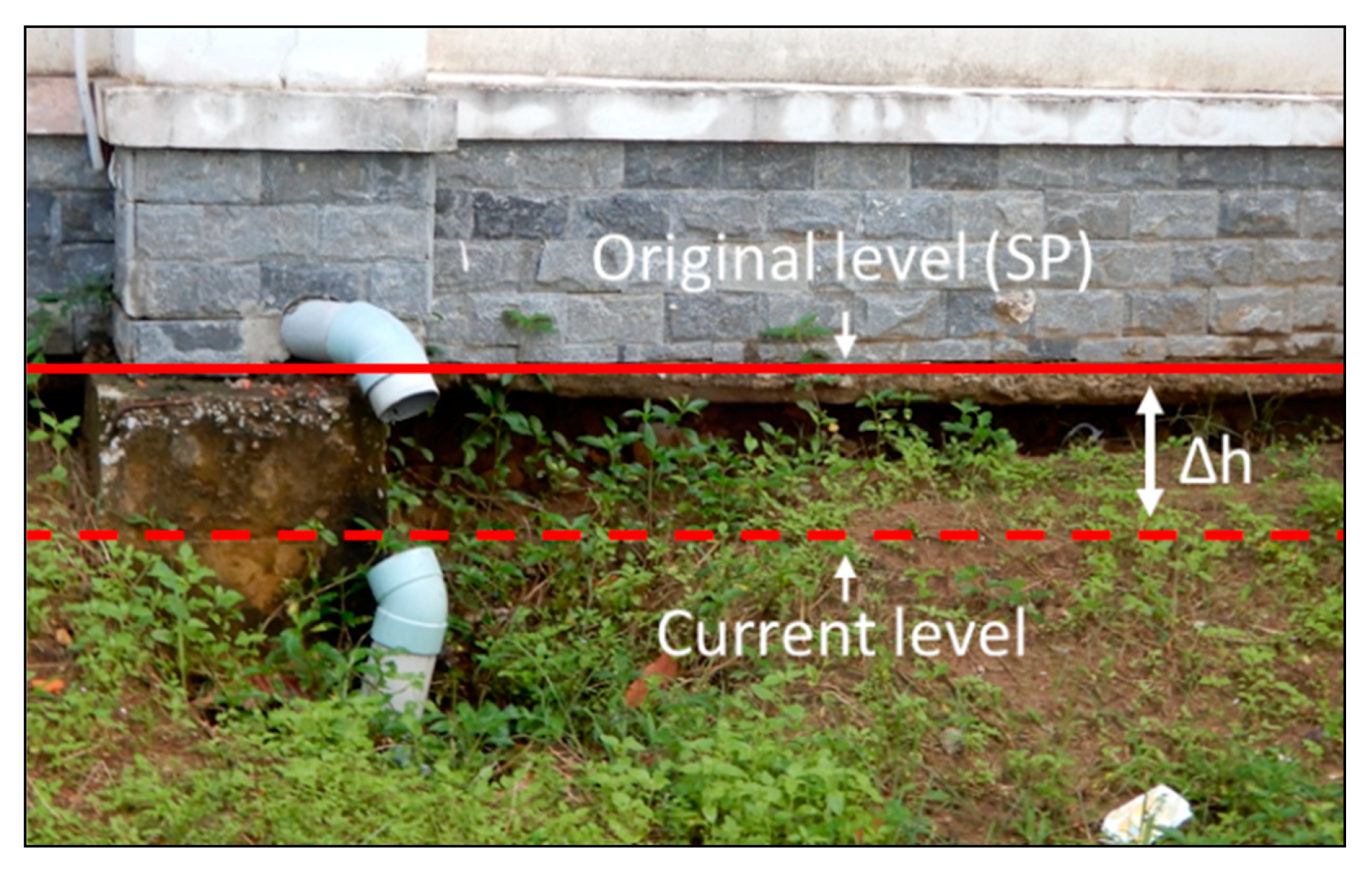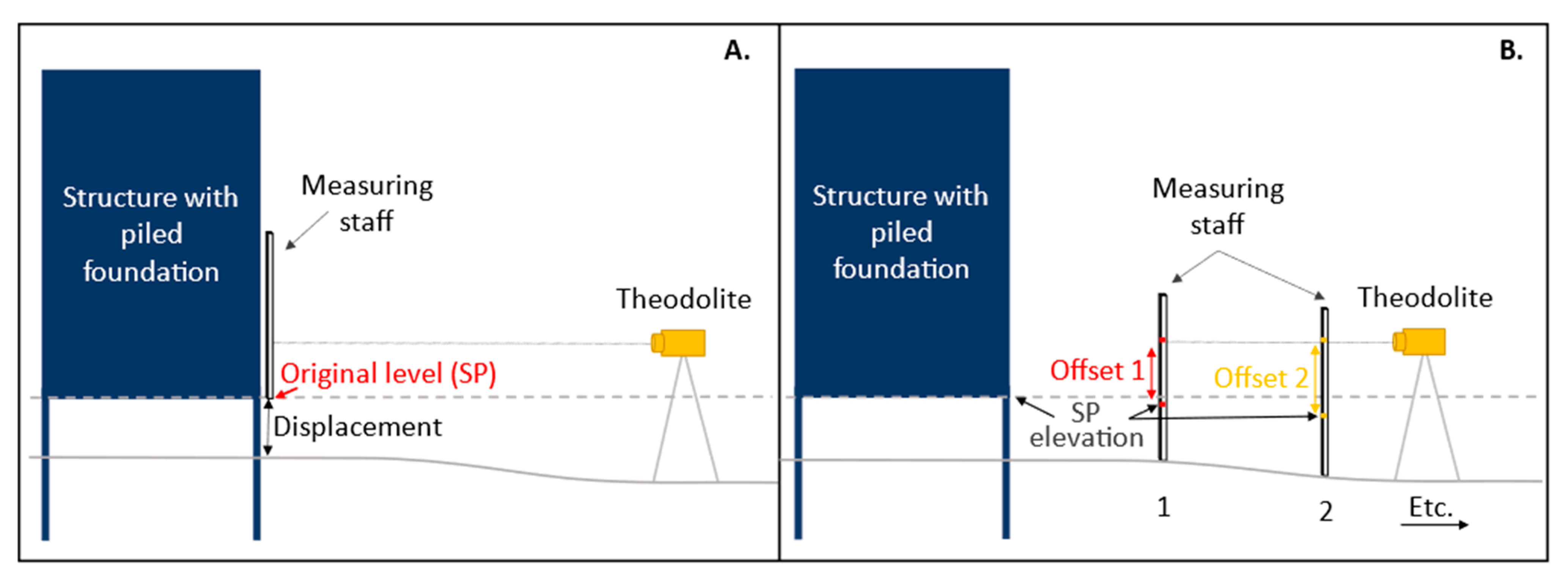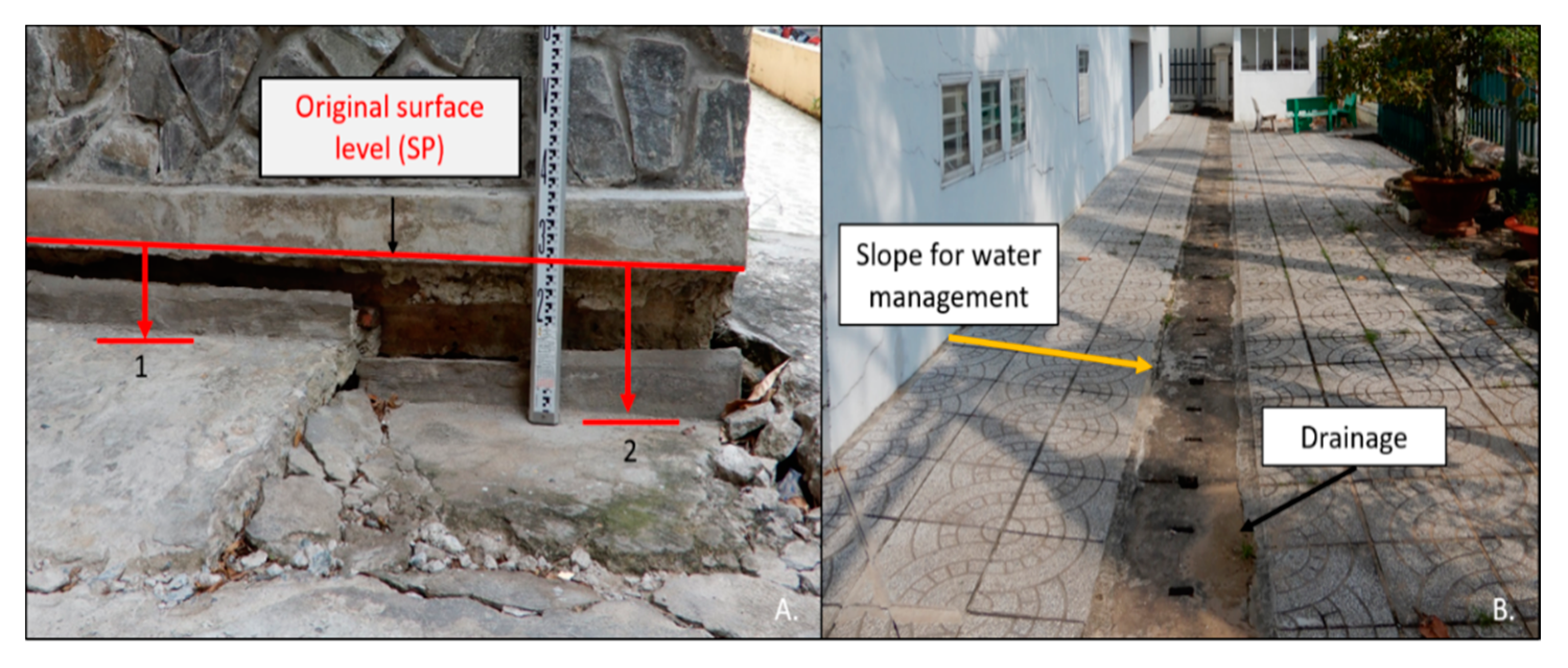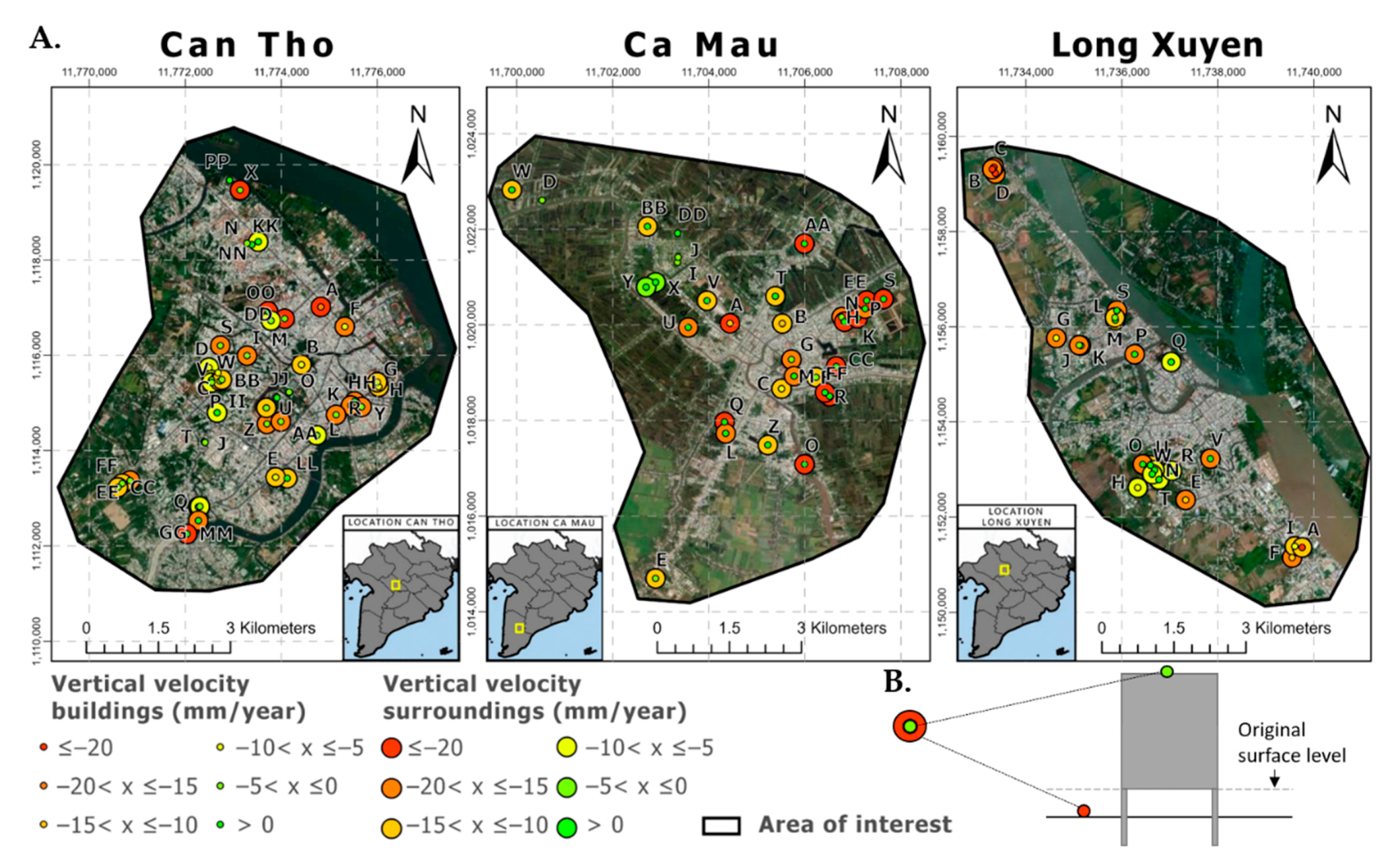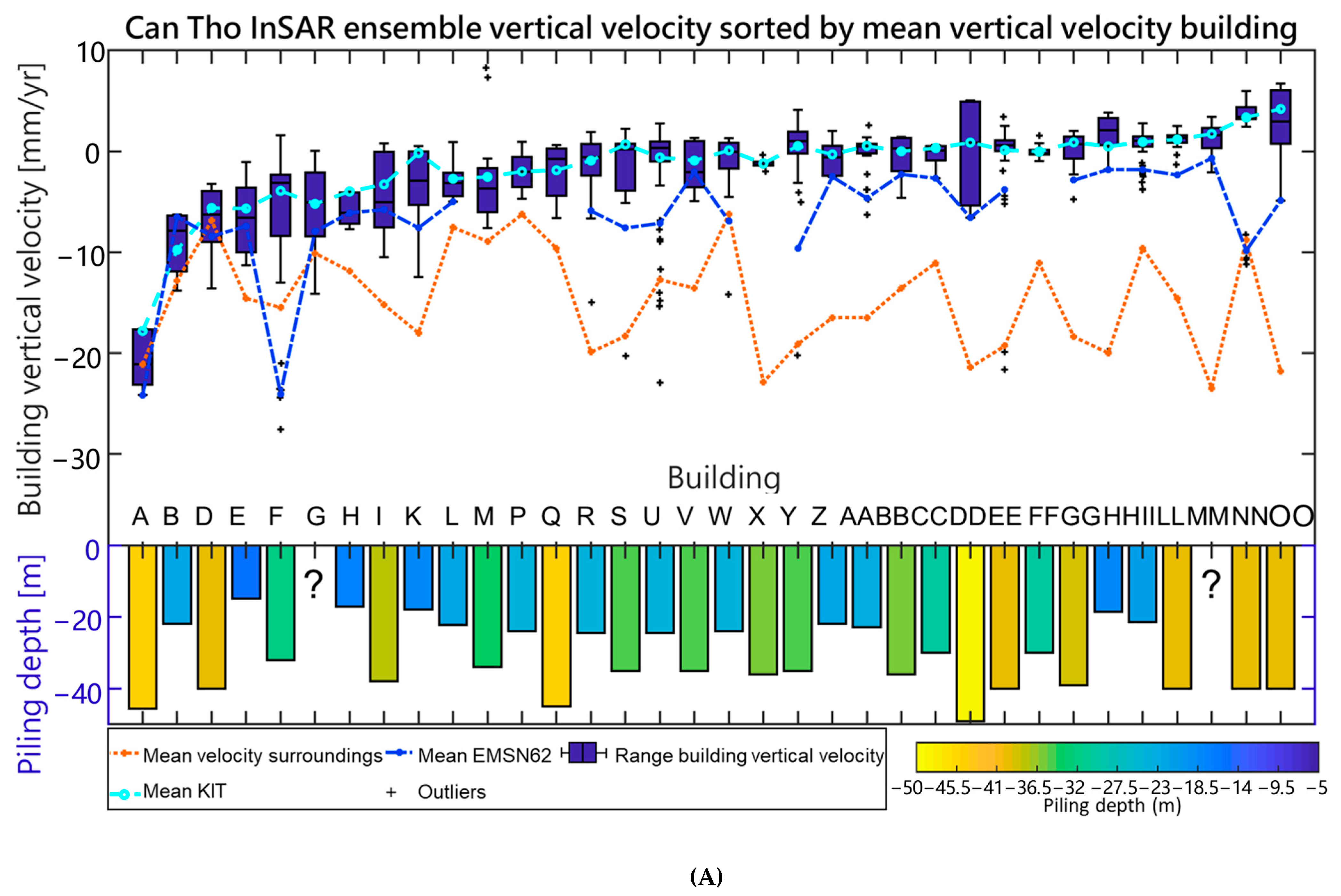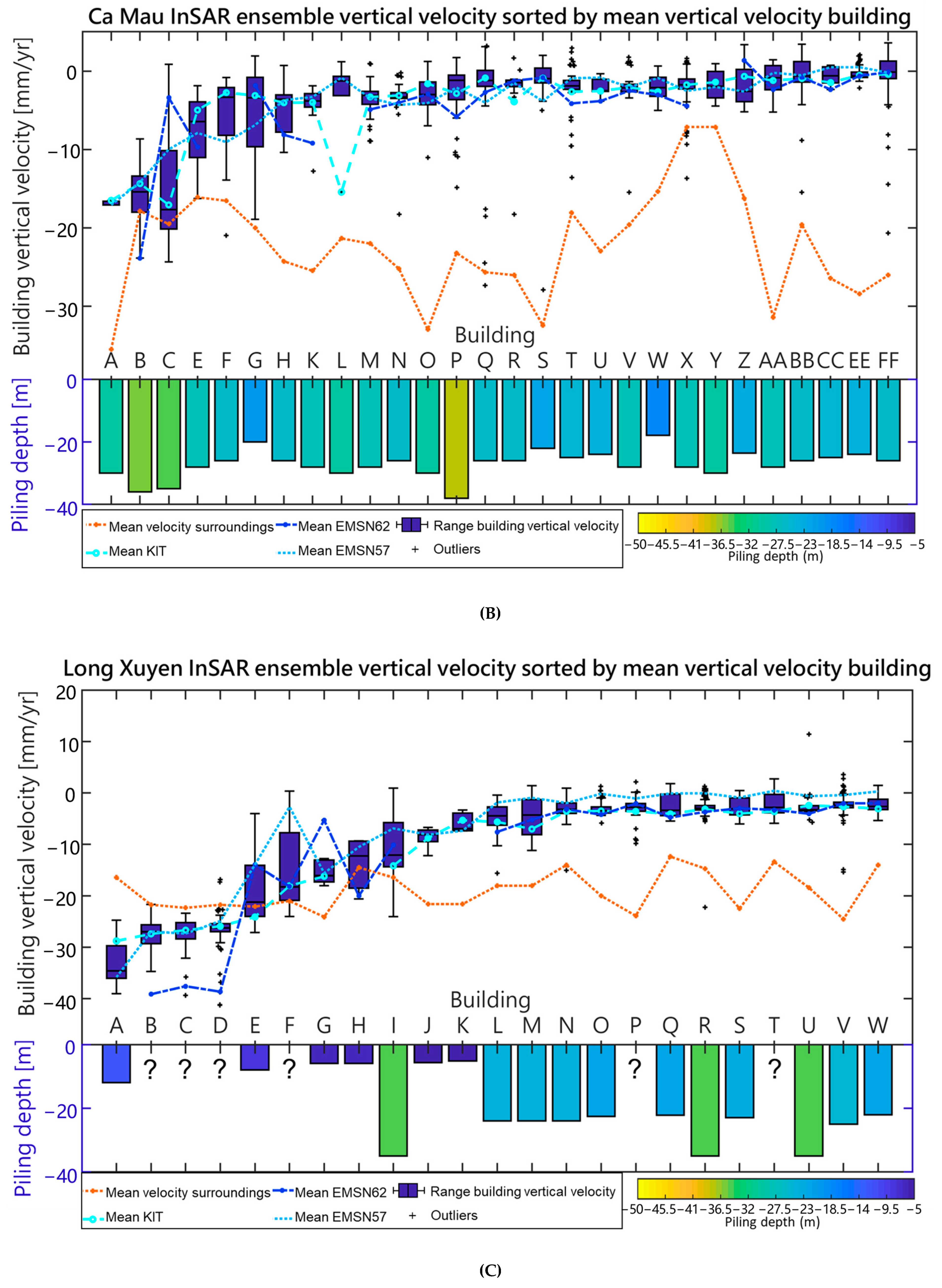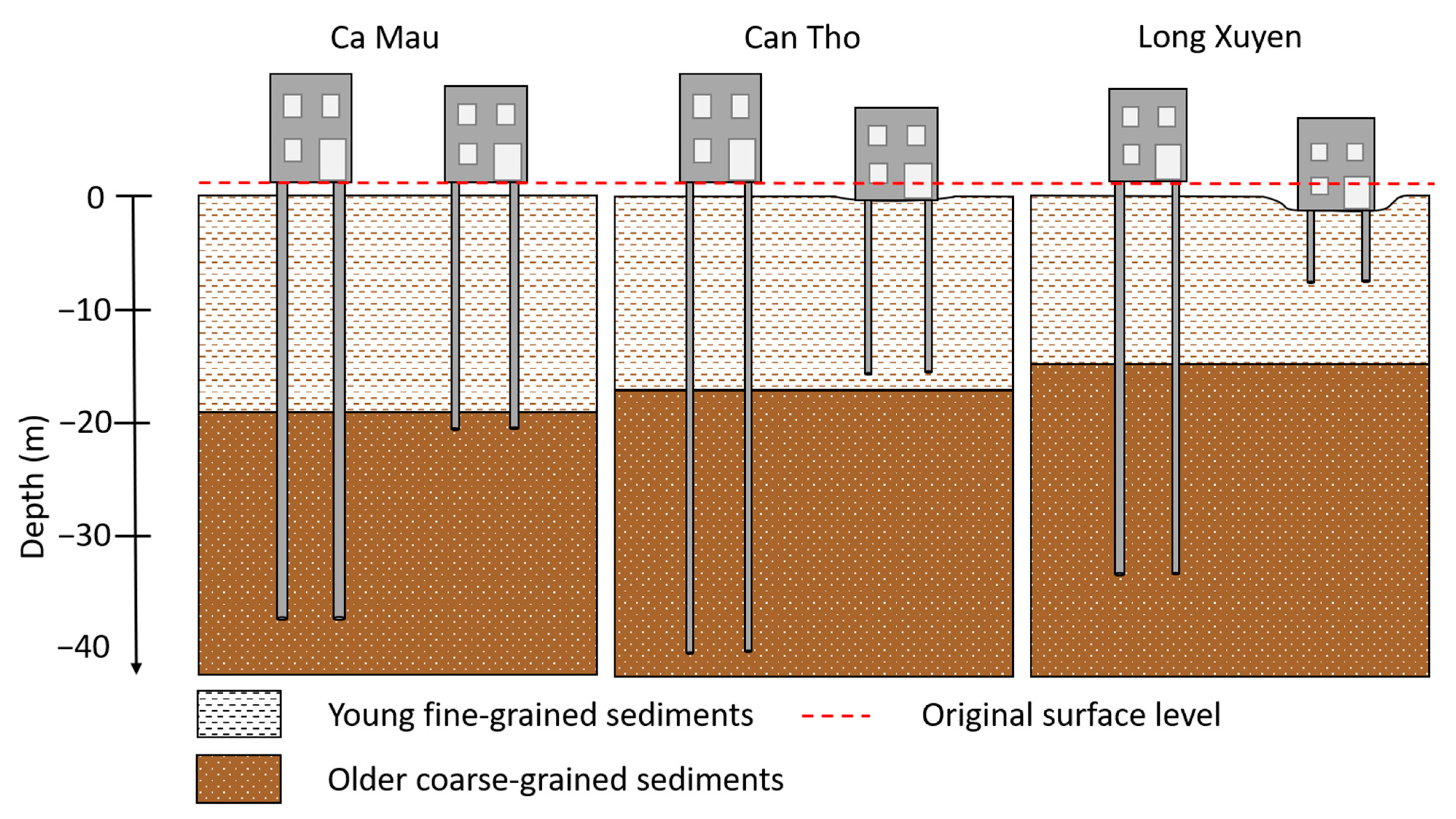Appendix B.3.1. Comparing the EMSN57 and KIT Vertical Velocity Datasets
The EMSN57 and KIT InSAR-based vertical velocity datasets correlate quite well when comparing all absolute vertical velocities of the selected buildings and their surroundings in Ca Mau and Long Xuyen together (
Figure A2). The absolute vertical velocities from the surroundings correspond less well than those from the buildings; however, combining all these absolute velocities does show a clear linear trend indicated by the Pearson rho of 0.88 and the R
2 of 0.77 for the linear fit (
Table A1 and
Figure A2). The correlations are weaker for the data from Ca Mau than that from Long Xuyen. The absolute velocity data from Ca Mau shows the EMSN57 velocity data to be slightly higher than the KIT velocity data, whilst in Long Xuyen it is the other way around. Combining the data from both cities shows that the linear fit is close to a perfect fit but shows a slight offset with the velocities from the KIT data being 0.49 mm/year lower than the velocities from the EMSN57 dataset.
The relative velocities of the surroundings compared to the buildings are aligning very well between the KIT and EMSN57 dataset (
Figure A2 and
Table A1). The Pearson rho is 0.81 for the relative data, and the linear fit has a R
2 of 0.65. The linear fit shows that there is slight offset with the KIT velocity data being 1.09 mm/year higher than the EMSN57 velocity data, but otherwise the two datasets align very well. The relative velocities are higher in Ca Mau than in Long Xuyen according to
Figure A3. The average offsets are small for the dataset with Long Xuyen and Ca Mau combined, −0.88 mm/year and σ is 4.91 mm/year for the absolute velocities and 1.36 mm/year and σ is 6.87 mm/year for the relative velocities (
Table A2). The standard deviations are of a similar magnitude as the uncertainty of an individual InSAR velocity dataset which is approximately 5 mm/year.
Figure A2.
Comparison between the average absolute vertical velocities extracted from the KIT InSAR-based velocity dataset (x-axis) and EMSN57 InSAR-based velocity dataset (y-axis). Both the velocity from the buildings (*) and the surroundings (x) are plotted. The data from Ca Mau (blue) and Long Xuyen (yellow) are included in the linear fit (dashed black line). The equation belonging to this fit is y = 0.97x + 0.49 with R2 = 0.77. The red dotted line shows a one-to-one perfect fit between the datasets.
Figure A2.
Comparison between the average absolute vertical velocities extracted from the KIT InSAR-based velocity dataset (x-axis) and EMSN57 InSAR-based velocity dataset (y-axis). Both the velocity from the buildings (*) and the surroundings (x) are plotted. The data from Ca Mau (blue) and Long Xuyen (yellow) are included in the linear fit (dashed black line). The equation belonging to this fit is y = 0.97x + 0.49 with R2 = 0.77. The red dotted line shows a one-to-one perfect fit between the datasets.
Table A1.
Results of statistical analysis of Ca Mau and Long Xuyen together between the velocity data of the KIT and EMSN57 InSAR-based datasets. Ntot shows the total number of buildings included in the dataset, and n shows the number that was used for the correlations. Ntot for all absolute data is twice the normal Ntot because this is the data from the buildings and surroundings combined. For both Spearman’s and Pearson correlation the Rho shows the strength of the correlation (between −1 and 1, with zero showing no correlation) and the p-value shows the statistical significance of the correlation (p-values < 0.05 shows is statistically valid). Both the mean offset between the datasets (Δ), and the standard deviation (σ) are given. The parameters from the linear fit depict the values from y = ax + b. The R2 gives the significance of the linear fit adjusted to n.
Table A1.
Results of statistical analysis of Ca Mau and Long Xuyen together between the velocity data of the KIT and EMSN57 InSAR-based datasets. Ntot shows the total number of buildings included in the dataset, and n shows the number that was used for the correlations. Ntot for all absolute data is twice the normal Ntot because this is the data from the buildings and surroundings combined. For both Spearman’s and Pearson correlation the Rho shows the strength of the correlation (between −1 and 1, with zero showing no correlation) and the p-value shows the statistical significance of the correlation (p-values < 0.05 shows is statistically valid). Both the mean offset between the datasets (Δ), and the standard deviation (σ) are given. The parameters from the linear fit depict the values from y = ax + b. The R2 gives the significance of the linear fit adjusted to n.
| Dataset | n | Spearman’s | Pearson | Mean Data Offset | Linear Fit |
|---|
| | | Rho | p-Value | Rho | p-Value | Δ [mm/yr] | σ [mm/yr] | Interception (b) | Direction Coefficient (a) | R2 |
|---|
| Buildings | 51 | 0.59 | 5.5 × 10−6 | 0.86 | 3.6 × 10−16 | −1.59 | 4.23 | 0.65 | 0.87 | 0.74 |
| Surroundings | 40 | 0.58 | 7.6 × 10−5 | 0.52 | 5.2 × 10−4 | 0.03 | 5.59 | −6.08 | 0.70 | 0.26 |
| All absolute | 91 | 0.85 | 1.0 × 10−26 | 0.88 | 3.7 × 10−30 | −0.88 | 4.91 | 0.49 | 0.97 | 0.77 |
| Relative | 40 | 0.76 | 1.8 × 10−8 | 0.81 | 2.0 × 10−10 | 1.36 | 6.87 | −1.09 | 1.02 | 0.65 |
Figure A3.
Comparison between the average relative vertical velocities of the surroundings compared to the buildings calculated from the KIT InSAR-based velocity dataset (x-axis) and EMSN57 InSAR-based velocity dataset (y-axis). The data from Ca Mau (blue) and Long Xuyen (yellow) are included in the linear fit (dashed black line). The equation belonging to this fit is y = 1.02x − 1.09 with R2 = 0.65. The red dotted line shows a one-to-one perfect fit between the datasets.
Figure A3.
Comparison between the average relative vertical velocities of the surroundings compared to the buildings calculated from the KIT InSAR-based velocity dataset (x-axis) and EMSN57 InSAR-based velocity dataset (y-axis). The data from Ca Mau (blue) and Long Xuyen (yellow) are included in the linear fit (dashed black line). The equation belonging to this fit is y = 1.02x − 1.09 with R2 = 0.65. The red dotted line shows a one-to-one perfect fit between the datasets.
Appendix B.3.2. Comparing the EMSN62 and KIT Vertical Velocity Datasets
The KIT and EMSN62 InSAR-based vertical velocity datasets do show a linear correlation with each other but there is an offset showing higher velocities for the EMSN62 dataset, for both the absolute and relative velocities (
Figure A4 and
Figure A5 and
Table A2). The combined absolute velocity data from all three cities show a mean offset of 5.52 mm/year. However, the mean offsets from the vertical velocities of the surroundings are always higher than those from the buildings, being 8.74 mm/year and 2.92 mm/year respectively for the combined city data (
Table A2). Also, there is less spread, and the standard deviation is lower for the building velocities (
Table A2). Considering that the surroundings are in general moving at higher velocities than the buildings (
Figure A4), this shows that the offset between the two datasets increases for higher velocities, but the uncertainty of the offset also increases.
The absolute velocities from the surroundings show the weakest correlation, similar to the comparison between the KIT and EMSN57 velocity data, with a Spearman’s rho of 0.47 and a Pearson’s rho of 0.45. However, combined with the absolute building velocities, the Pearson’s rho becomes 0.81 and the linear fit has an R
2 of 0.65. The relative velocities of the surroundings compared to the buildings align quite well comparing the fitted trend between the KIT and EMSN62 dataset with the perfect fit, but with the EMSN62 velocity data being 6.8 mm/year higher than the KIT velocity data (
Figure A5 and
Table A2). The Pearson rho is 0.62 for the relative data, and the linear fit has a R
2 of 0.34. The relative velocities are highest in Ca Mau and of similar rates in Long Xuyen and Can Tho according to
Figure A5.
Figure A4.
Comparison between the average absolute vertical velocities extracted from the KIT InSAR-based velocity dataset (x-axis) and EMSN62 InSAR-based velocity dataset (y-axis). Both the velocity from the buildings (*) and the surroundings (x) are plotted. The data from Ca Mau (blue), Can Tho (red) and Long Xuyen (yellow) are included in the linear fit (dashed black line). The equation belonging to this fit is y = 1.12x − 4.31 with R2 = 0.65. The red dotted line shows a 1-to-1 perfect fit between the datasets.
Figure A4.
Comparison between the average absolute vertical velocities extracted from the KIT InSAR-based velocity dataset (x-axis) and EMSN62 InSAR-based velocity dataset (y-axis). Both the velocity from the buildings (*) and the surroundings (x) are plotted. The data from Ca Mau (blue), Can Tho (red) and Long Xuyen (yellow) are included in the linear fit (dashed black line). The equation belonging to this fit is y = 1.12x − 4.31 with R2 = 0.65. The red dotted line shows a 1-to-1 perfect fit between the datasets.
Table A2.
Results of statistical analysis of Ca Mau, Can Tho and Long Xuyen together between the velocity data of the KIT and EMSN62 InSAR-based datasets. Ntot shows the total number of buildings included in the dataset, and n shows the number that was used for the correlations. Ntot for all absolute data is twice the normal Ntot because this is the data from the buildings and surroundings combined. For both Spearman’s and Pearson correlation the Rho shows the strength of the correlation (between −1 and 1, with zero showing no correlation) and the p-value shows the statistical significance of the correlation (p-values < 0.05 shows is statistically valid). Both the mean offset between the datasets (Δ), and the standard deviation (σ) are given. The parameters from the linear fit depict the values from y = ax + b. The R2 gives the significance of the linear fit adjusted to n.
Table A2.
Results of statistical analysis of Ca Mau, Can Tho and Long Xuyen together between the velocity data of the KIT and EMSN62 InSAR-based datasets. Ntot shows the total number of buildings included in the dataset, and n shows the number that was used for the correlations. Ntot for all absolute data is twice the normal Ntot because this is the data from the buildings and surroundings combined. For both Spearman’s and Pearson correlation the Rho shows the strength of the correlation (between −1 and 1, with zero showing no correlation) and the p-value shows the statistical significance of the correlation (p-values < 0.05 shows is statistically valid). Both the mean offset between the datasets (Δ), and the standard deviation (σ) are given. The parameters from the linear fit depict the values from y = ax + b. The R2 gives the significance of the linear fit adjusted to n.
| Dataset | n | Spearman’s | Pearson | Mean Data Offset | Linear Fit |
|---|
| | | Rho | p-Value | Rho | p-Value | Δ [mm/yr] | σ [mm/yr] | Interception (b) | Direction Coefficient (a) | R2 |
|---|
| Buildings | 78 | 0.42 | 1.4 × 10−4 | 0.75 | 1.5 × 10−15 | 2.92 | 5.36 | −3.36 | 0.89 | 0.56 |
| Surroundings | 63 | 0.47 | 1.1 × 10−4 | 0.45 | 2.3 × 10−4 | 8.74 | 8.19 | −14.3 | 0.67 | 0.19 |
| All absolute | 141 | 0.80 | 1.1 × 10−32 | 0.81 | 5.0 × 10−34 | 5.52 | 7.34 | −4.31 | 1.12 | 0.65 |
| Relative | 56 | 0.55 | 9.4 × 10−6 | 0.62 | 3.3 × 10−7 | 6.24 | 9.75 | −6.81 | 0.95 | 0.37 |
Figure A5.
Comparison between the average relative vertical velocities of the surroundings compared to the buildings calculated from the KIT InSAR-based velocity dataset (x-axis) and EMSN62 InSAR-based velocity dataset (y-axis). The data from Ca Mau (blue), Can Tho (red) and Long Xuyen (yellow) are included in the linear fit (dashed black line). The equation belonging to this fit is y = 0.95x − 6.81 with R2 = 0.37. The red dotted line shows a 1-to-1 perfect fit between the datasets.
Figure A5.
Comparison between the average relative vertical velocities of the surroundings compared to the buildings calculated from the KIT InSAR-based velocity dataset (x-axis) and EMSN62 InSAR-based velocity dataset (y-axis). The data from Ca Mau (blue), Can Tho (red) and Long Xuyen (yellow) are included in the linear fit (dashed black line). The equation belonging to this fit is y = 0.95x − 6.81 with R2 = 0.37. The red dotted line shows a 1-to-1 perfect fit between the datasets.
Appendix B.3.3. Comparing the EMSN57 and EMSN62 Vertical Velocity Datasets
The EMSN57 and EMSN62 InSAR-based vertical velocity datasets show a linear correlation but the EMSN62 dataset has higher velocities than the EMSN57 (
Figure A6 and
Figure A7 and
Table A3). For the combined absolute velocities of Ca Mau and Long Xuyen together the mean offset is 4.71 mm/year. Similar to the comparison between the KIT and EMSN62 datasets, the mean offset from the surroundings velocity data is higher (7.04 mm/year) than the building velocity data (2.83 mm/year). The linear fit coefficient is 1.16 which also shows an increase in offset for increasing velocities. The spread is highest, and the linear correlations are weakest for the velocities of the surroundings (σ is 7.46 mm/year and R
2 is 0.31,
Table A3).
Figure A6.
Comparison between the average absolute vertical velocities extracted from the EMSN57 InSAR-based velocity dataset (x-axis) and EMSN62 InSAR-based velocity dataset (y-axis). Both the velocity from the buildings (*) and the surroundings (x) are plotted. The data from Ca Mau (blue) and Long Xuyen (yellow) are included in the linear fit (dashed black line). The equation belonging to this fit is y = 1.16x − 2.90 with R2 = 0.77. The red dotted line shows a one-to-one perfect fit between the datasets.
Figure A6.
Comparison between the average absolute vertical velocities extracted from the EMSN57 InSAR-based velocity dataset (x-axis) and EMSN62 InSAR-based velocity dataset (y-axis). Both the velocity from the buildings (*) and the surroundings (x) are plotted. The data from Ca Mau (blue) and Long Xuyen (yellow) are included in the linear fit (dashed black line). The equation belonging to this fit is y = 1.16x − 2.90 with R2 = 0.77. The red dotted line shows a one-to-one perfect fit between the datasets.
Table A3.
Results of statistical analysis of Ca Mau and Long Xuyen together between the velocity data of the EMSN57 and EMSN62 InSAR-based datasets. Ntot shows the total number of buildings included in the dataset, and n shows the number that was used for the correlations. Ntot for all absolute data is twice the normal Ntot because this is the data from the buildings and surroundings combined. For both Spearman’s and Pearson correlation the Rho shows the strength of the correlation (between −1 and 1, with zero showing no correlation) and the p-value shows the statistical significance of the correlation (p-values < 0.05 shows is statistically valid). Both the mean offset between the datasets (Δ), and the standard deviation (σ) are given. The parameters from the linear fit depict the values from y = ax + b. R2 gives the significance of the linear fit adjusted to n.
Table A3.
Results of statistical analysis of Ca Mau and Long Xuyen together between the velocity data of the EMSN57 and EMSN62 InSAR-based datasets. Ntot shows the total number of buildings included in the dataset, and n shows the number that was used for the correlations. Ntot for all absolute data is twice the normal Ntot because this is the data from the buildings and surroundings combined. For both Spearman’s and Pearson correlation the Rho shows the strength of the correlation (between −1 and 1, with zero showing no correlation) and the p-value shows the statistical significance of the correlation (p-values < 0.05 shows is statistically valid). Both the mean offset between the datasets (Δ), and the standard deviation (σ) are given. The parameters from the linear fit depict the values from y = ax + b. R2 gives the significance of the linear fit adjusted to n.
| Dataset | n | Spearman’s | Pearson | Mean Data Offset | Linear Fit |
|---|
| | | Rho | p-Value | Rho | p-Value | Δ [mm/yr] | σ [mm/yr] | Interception (b) | Direction Coefficient (a) | R2 |
|---|
| Buildings | 46 | 0.58 | 3 × 10−5 | 0.87 | 2 × 10−15 | 2.83 | 4.94 | −1.81 | 1.21 | 0.76 |
| Surroundings | 37 | 0.56 | 4 × 10−4 | 0.57 | 2 × 10−4 | 7.04 | 7.46 | −12.1 | 0.75 | 0.31 |
| All absolute | 83 | 0.87 | 5 × 10−26 | 0.88 | 4 × 10−28 | 4.71 | 6.50 | −2.90 | 1.16 | 0.77 |
| Relative | 34 | 0.60 | 2 × 10−4 | 0.75 | 3 × 10−7 | 4.14 | 9.79 | −2.53 | 1.11 | 0.55 |
In the comparison of the relative velocities of the surroundings compared to the buildings as similar increase in offset with an increase in vertical velocity is visible, with the EMSN62 velocity data showing on average 4.14 mm/year higher velocities than the KIT velocity dataset (
Figure A7 and
Table A3). However, the σ is 9.97 mm/year and the R
2 of the linear fit is 0.55, showing a larger uncertainty than the absolute velocities (
Table A3). The relative velocities are again higher in Ca Mau than in Long Xuyen (
Figure A7).
Figure A7.
Comparison between the average relative vertical velocities of the surroundings compared to the buildings calculated from the EMSN57 InSAR-based velocity dataset (x-axis) and EMSN62 InSAR-based velocity dataset (y-axis). The data from Ca Mau (blue) and Long Xuyen (yellow) are included in the linear fit (dashed black line). The equation belonging to this fit is y = 1.11x − 2.53 with R2 = 0.55. The red dotted line shows a 1-to-1 perfect fit between the datasets.
Figure A7.
Comparison between the average relative vertical velocities of the surroundings compared to the buildings calculated from the EMSN57 InSAR-based velocity dataset (x-axis) and EMSN62 InSAR-based velocity dataset (y-axis). The data from Ca Mau (blue) and Long Xuyen (yellow) are included in the linear fit (dashed black line). The equation belonging to this fit is y = 1.11x − 2.53 with R2 = 0.55. The red dotted line shows a 1-to-1 perfect fit between the datasets.
Appendix B.3.4. Comparing Field-, and InSAR-Based Velocity Datasets
From the offsets measured in the field result only the relative vertical movement of the surroundings compared to the buildings can be calculated. Therefore, only relative velocities could be compared to the InSAR-based velocity datasets. The comparison of these relative vertical velocities obtained from the InSAR-based velocity datasets and the vertical velocities calculated from the offsets measured in the field, shows that there is a weak correlation between these datasets (
Figure A8,
Figure A9 and
Figure A10 and
Table A4,
Table A5 and
Table A6). Combining the velocity data from each city does show a significant positive trend according to the Spearman’s rho (0.26 for the KIT and EMSN57 velocity datasets and 0.41 for the EMSN62 velocity dataset (
Table A4,
Table A5 and
Table A6). Possibly, the lower
p-values, indicating a stronger statistical trend, are due to the higher number of values tested (n).
Separating the data for each city shows that the velocity data from Long Xuyen show the best correlation between the field-, and InSAR-based relative velocities according to the low
p-values (
Table A4,
Table A5 and
Table A6). However, the linear trend fitted indicates that the velocities based on the field measurements are three times higher than the InSAR-based relative velocities. The mean offset from the Long Xuyen data shows that the field-based relative velocities are ~24 mm/year higher than those from the InSAR-based datasets, whilst in Can Tho and Ca Mau the field-based velocities are ~5 mm/year higher according to the EMSN57 and KIT velocity datasets and ~1 mm/year lower according to the EMSN62 velocity dataset. This shows that in Ca Mau and Can Tho the relative velocity rates of the field-based velocity dataset and the InSAR-based velocity dataset are more similar. This is also visible in
Figure A7 and
Figure A8 (Ca Mau and Can Tho) where the data points are closer to the perfect fit line, whereas, in
Figure A9 (Long Xuyen), the data points are further away from this line.
Figure A8.
Comparison between the average relative vertical velocities of the surroundings compared to the buildings in Ca Mau calculated from the offsets measured in the field (x-axis) and calculated from the InSAR-based velocity dataset (y-axis). The velocity datasets from KIT (blue), EMSN57 (yellow) and EMSN62 (red) are included and the colored dashed lines and equations show the corresponding linear trends between the separate InSAR velocity datasets and the field velocity datasets. The dotted black line shows the one-to-one perfect fit between field-, and InSAR-based relative velocities. All InSAR datasets show a weak trend with the velocity dataset, but most data points are close to the perfect fit line, indicating a similarity in the values.
Figure A8.
Comparison between the average relative vertical velocities of the surroundings compared to the buildings in Ca Mau calculated from the offsets measured in the field (x-axis) and calculated from the InSAR-based velocity dataset (y-axis). The velocity datasets from KIT (blue), EMSN57 (yellow) and EMSN62 (red) are included and the colored dashed lines and equations show the corresponding linear trends between the separate InSAR velocity datasets and the field velocity datasets. The dotted black line shows the one-to-one perfect fit between field-, and InSAR-based relative velocities. All InSAR datasets show a weak trend with the velocity dataset, but most data points are close to the perfect fit line, indicating a similarity in the values.
Figure A9.
Comparison between the average relative vertical velocities of the surroundings compared to the buildings in Can Tho calculated from the offsets measured in the field (x-axis) and calculated from the InSAR-based velocity dataset (y-axis). The velocity datasets from KIT (blue) and EMSN62 (red) are included and the colored dashed lines and equations show the corresponding linear trends between the separate InSAR velocity datasets and the field velocity datasets. The dotted black line shows the one-to-one perfect fit between field-, and InSAR-based relative velocities. All InSAR datasets show a weak trend with the velocity dataset, but most data points are somewhat close to the perfect fit line, indicating a similarity in the values.
Figure A9.
Comparison between the average relative vertical velocities of the surroundings compared to the buildings in Can Tho calculated from the offsets measured in the field (x-axis) and calculated from the InSAR-based velocity dataset (y-axis). The velocity datasets from KIT (blue) and EMSN62 (red) are included and the colored dashed lines and equations show the corresponding linear trends between the separate InSAR velocity datasets and the field velocity datasets. The dotted black line shows the one-to-one perfect fit between field-, and InSAR-based relative velocities. All InSAR datasets show a weak trend with the velocity dataset, but most data points are somewhat close to the perfect fit line, indicating a similarity in the values.
Figure A10.
Comparison between the average relative vertical velocities of the surroundings compared to the buildings in Long Xuyen calculated from the offsets measured in the field (x-axis) and calculated from the InSAR-based velocity dataset (y-axis), using the year construction was started as a correction for the large offsets in relative velocity. The velocity datasets from KIT (blue), EMSN57 (yellow) and EMSN62 (red) are included and the colored dashed lines and equations show the corresponding linear trends between the separate InSAR velocity datasets and the field velocity datasets. The dotted black line shows the one-to-one perfect fit between field-, and InSAR-based relative velocities. All InSAR datasets show a moderate trend with the velocity dataset, but the field-based velocities are three times higher than those from the InSAR-based datasets.
Figure A10.
Comparison between the average relative vertical velocities of the surroundings compared to the buildings in Long Xuyen calculated from the offsets measured in the field (x-axis) and calculated from the InSAR-based velocity dataset (y-axis), using the year construction was started as a correction for the large offsets in relative velocity. The velocity datasets from KIT (blue), EMSN57 (yellow) and EMSN62 (red) are included and the colored dashed lines and equations show the corresponding linear trends between the separate InSAR velocity datasets and the field velocity datasets. The dotted black line shows the one-to-one perfect fit between field-, and InSAR-based relative velocities. All InSAR datasets show a moderate trend with the velocity dataset, but the field-based velocities are three times higher than those from the InSAR-based datasets.
Comparing the mean offset of the different InSAR-based velocity datasets show that the EMSN62 velocity dataset has the lowest offset from the field-based velocity dataset, excluding the data from Long Xuyen (
Table A4). The relative velocities from the field data were on average lower than the velocities from the EMSN62 dataset, with 0.92 mm/year in Ca Mau and 1.19 mm/year in Can Tho (
Table A4). For the relative velocities from the KIT and EMSN57 InSAR datasets the offset shows that on average the field-based velocities were ~5 mm/year higher than the InSAR-based velocities. This is similar to the offset found between the EMSN62 InSAR dataset and the KIT and EMSN57 InSAR datasets. However, it is important to keep in mind the large standard deviations, between 11.2 mm/year and 23.3 mm/year, which indicate a large spread of the velocity offsets between the datasets and add uncertainty to the mean offsets (
Table A4).
Table A4.
Results of statistical analysis between the velocity data of the relative velocities calculated from the offsets measured in the field and from KIT InSAR-based velocity dataset. Ntot shows the total number of buildings included in the dataset, and n shows the number that was used for the correlations. Ntot for all absolute data is twice the normal Ntot because this is the data from the buildings and surroundings combined. For both Spearman’s and Pearson correlation, Rho shows the strength of the correlation (between −1 and 1, with zero showing no correlation) and the p-value shows the statistical significance of the correlation (p-values < 0.05 shows is statistically valid). Both the mean offset between the datasets (Δ), and the standard deviation (σ) are given. The parameters from the linear fit depict the values from y = ax + b. R2 gives the significance of the linear fit adjusted to n.
Table A4.
Results of statistical analysis between the velocity data of the relative velocities calculated from the offsets measured in the field and from KIT InSAR-based velocity dataset. Ntot shows the total number of buildings included in the dataset, and n shows the number that was used for the correlations. Ntot for all absolute data is twice the normal Ntot because this is the data from the buildings and surroundings combined. For both Spearman’s and Pearson correlation, Rho shows the strength of the correlation (between −1 and 1, with zero showing no correlation) and the p-value shows the statistical significance of the correlation (p-values < 0.05 shows is statistically valid). Both the mean offset between the datasets (Δ), and the standard deviation (σ) are given. The parameters from the linear fit depict the values from y = ax + b. R2 gives the significance of the linear fit adjusted to n.
| Dataset | n | Spearman’s | Pearson | Mean Data Offset | Linear Fit |
|---|
| | | Rho | p-Value | Rho | p-Value | Δ [mm/yr] | σ [mm/yr] | Interception (b) | Direction Coefficient (a) | R2 |
|---|
| All cities | 74 | 0.29 | 0.01 | 0.22 | 0.06 | −7.79 | 15.0 | −9.16 | 0.12 | 0.04 |
| Ca Mau | 21 | −0.02 | 0.95 | −0.05 | 0.84 | −5.0 | 17.1 | −17.57 | −0.02 | −0.05 |
| Can Tho | 31 | 0.29 | 0.11 | 0.37 | 0.04 | −4.7 | 11.2 | −7.48 | 0.19 | 0.11 |
| Long Xuyen | 22 | 0.31 | 0.16 | 0.33 | 0.13 | −14.8 | 15.7 | −3.97 | 0.18 | 0.06 |
Table A5.
Results of statistical analysis between the velocity data of the relative velocities calculated from the offsets measured in the field and from EMSN62 InSAR-based velocity dataset. Ntot shows the total number of buildings included in the dataset, and n shows the number that was used for the correlations. Ntot for all absolute data is twice the normal Ntot because this is the data from the buildings and surroundings combined. For both Spearman’s and Pearson correlation, Rho shows the strength of the correlation (between −1 and 1, with zero showing no correlation) and the p-value shows the statistical significance of the correlation (p-values < 0.05 shows is statistically valid). Both the mean offset between the datasets (Δ), and the standard deviation (σ) are given. The parameters from the linear fit depict the values from y = ax + b. R2 gives the significance of the linear fit adjusted to n.
Table A5.
Results of statistical analysis between the velocity data of the relative velocities calculated from the offsets measured in the field and from EMSN62 InSAR-based velocity dataset. Ntot shows the total number of buildings included in the dataset, and n shows the number that was used for the correlations. Ntot for all absolute data is twice the normal Ntot because this is the data from the buildings and surroundings combined. For both Spearman’s and Pearson correlation, Rho shows the strength of the correlation (between −1 and 1, with zero showing no correlation) and the p-value shows the statistical significance of the correlation (p-values < 0.05 shows is statistically valid). Both the mean offset between the datasets (Δ), and the standard deviation (σ) are given. The parameters from the linear fit depict the values from y = ax + b. R2 gives the significance of the linear fit adjusted to n.
| Dataset | n | Spearman’s | Pearson | Mean Data Offset | Linear Fit |
|---|
| | | Rho | p-Value | Rho | p-Value | Δ [mm/yr] | σ [mm/yr] | Interception (b) | Direction Coefficient (a) | R2 |
|---|
| All cities | 57 | 0.45 | 4.1 × 10−4 | 0.34 | 0.01 | −3.18 | 16.1 | −12.0 | 0.27 | 0.10 |
| Ca Mau | 14 | 0.41 | 0.14 | 0.24 | 0.40 | 0.92 | 17.1 | −23.7 | 0.10 | −0.02 |
| Can Tho | 24 | 0.30 | 0.15 | 0.18 | 0.41 | 1.19 | 13.0 | −14.3 | 0.10 | −0.01 |
| Long Xuyen | 19 | 0.64 | 2.9 × 10−3 | 0.50 | 0.03 | −11.7 | 16.3 | −0.04 | 0.53 | 0.20 |
Table A6.
Results of statistical analysis between the velocity data of the relative velocities calculated from the offsets measured in the field and from EMSN57 InSAR-based velocity dataset. Ntot shows the total number of buildings included in the dataset, and n shows the number that was used for the correlations. Ntot for all absolute data is twice the normal Ntot because this is the data from the buildings and surroundings combined. For both Spearman’s and Pearson correlation, Rho shows the strength of the correlation (between −1 and 1, with zero showing no correlation) and the p-value shows the statistical significance of the correlation (p-values < 0.05 shows is statistically valid). Both the mean offset between the datasets (Δ), and the standard deviation (σ) are given. The parameters from the linear fit depict the values from y = ax + b. R2 gives the significance of the linear fit adjusted to n.
Table A6.
Results of statistical analysis between the velocity data of the relative velocities calculated from the offsets measured in the field and from EMSN57 InSAR-based velocity dataset. Ntot shows the total number of buildings included in the dataset, and n shows the number that was used for the correlations. Ntot for all absolute data is twice the normal Ntot because this is the data from the buildings and surroundings combined. For both Spearman’s and Pearson correlation, Rho shows the strength of the correlation (between −1 and 1, with zero showing no correlation) and the p-value shows the statistical significance of the correlation (p-values < 0.05 shows is statistically valid). Both the mean offset between the datasets (Δ), and the standard deviation (σ) are given. The parameters from the linear fit depict the values from y = ax + b. R2 gives the significance of the linear fit adjusted to n.
| Dataset | n | Spearman’s | Pearson | Mean Data Offset | Linear Fit |
|---|
| | | Rho | p-Value | Rho | p-Value | Δ [mm/yr] | σ [mm/yr] | Interception (b) | Direction Coefficient (a) | R2 |
|---|
| All cities | 46 | 0.29 | 0.05 | 0.26 | 0.08 | −9.28 | 20.5 | −11.2 | 0.15 | 0.05 |
| Ca Mau | 24 | 0.23 | 0.27 | 0.14 | 0.51 | −4.91 | 23.30 | −20.1 | 0.04 | −0.02 |
| Long Xuyen | 22 | 0.45 | 0.03 | 0.39 | 0.07 | −14.0 | 16.2 | −1.53 | 0.30 | 0.11 |
Sorting the offsets between the field-, and InSAR-based relative velocities by age shows that the offset is higher for younger buildings in all three cities (
Figure A11). The offset was calculated the same way as in
Table A3,
Table A4,
Table A5 and
Table A6 (Field velocities—InSAR velocities), which means that more negative velocities indicate that the InSAR-based velocities are lower than the field-based velocities. According to
Figure A11, the offset between the datasets is highest for buildings younger than six years old, and the offset becomes smaller for older buildings.
Figure A11 again shows that in Long Xuyen the offset between the datasets is generally higher, also for the older buildings (Field-based velocities are ~15 mm/year higher than InSAR based velocities), than in Ca Mau and Can Tho.
Figure A11.
The average offset in relative velocity of the surroundings compared to the buildings, between each InSAR-based velocity dataset and the velocity data calculated from the offsets measured in the field, for every city. The velocity data of each dataset were sorted by age and the offset from the field-based relative velocities was calculated by subtracting the moving mean of the relative velocities (using a window of three data points) of the InSAR-based datasets from the moving mean of the field-based dataset (offset = field-InSAR). Furthermore, a fourth-order polynomial was fitted through the data to show the trend in the anomaly with age. Negative offsets show that the InSAR-based velocities are lower than the field-based velocities, and thus that the InSAR underestimates the field-based velocities.
Figure A11.
The average offset in relative velocity of the surroundings compared to the buildings, between each InSAR-based velocity dataset and the velocity data calculated from the offsets measured in the field, for every city. The velocity data of each dataset were sorted by age and the offset from the field-based relative velocities was calculated by subtracting the moving mean of the relative velocities (using a window of three data points) of the InSAR-based datasets from the moving mean of the field-based dataset (offset = field-InSAR). Furthermore, a fourth-order polynomial was fitted through the data to show the trend in the anomaly with age. Negative offsets show that the InSAR-based velocities are lower than the field-based velocities, and thus that the InSAR underestimates the field-based velocities.
